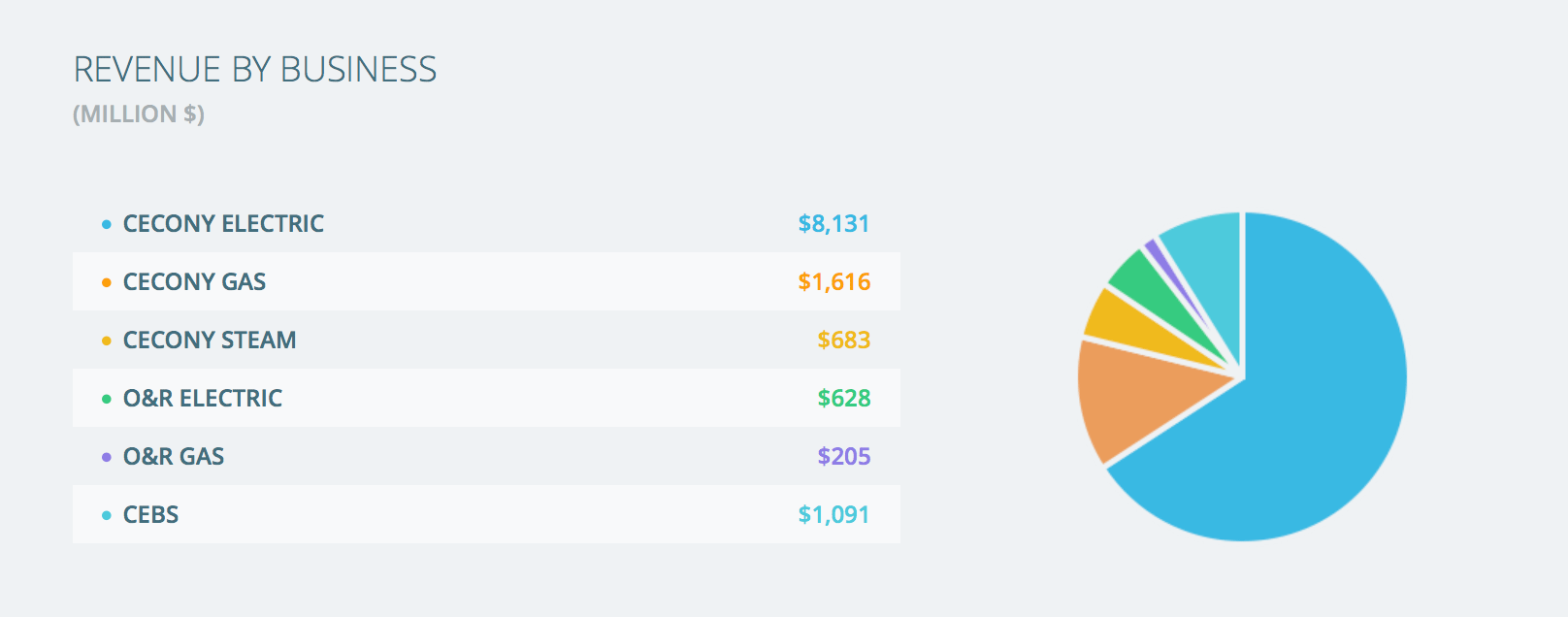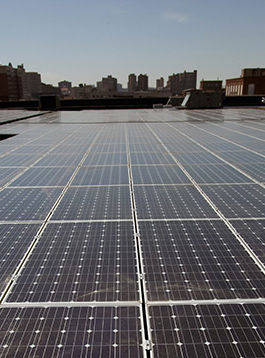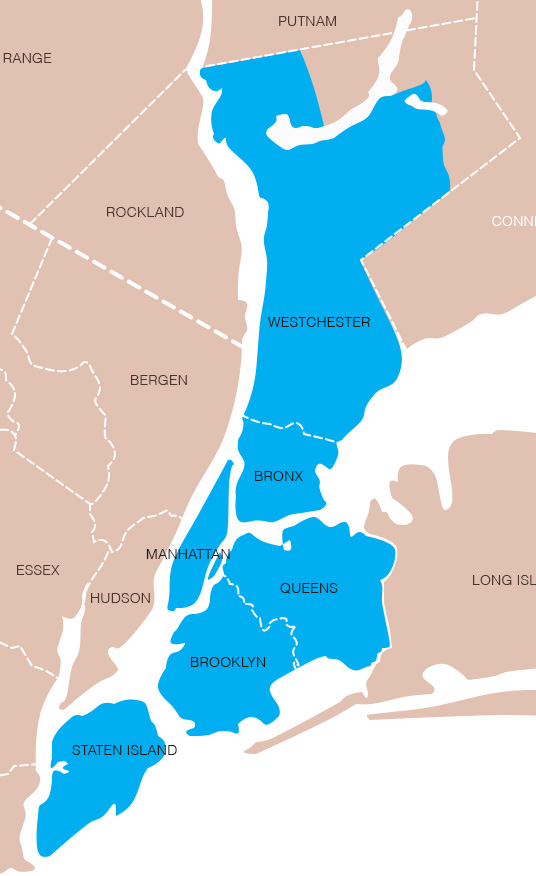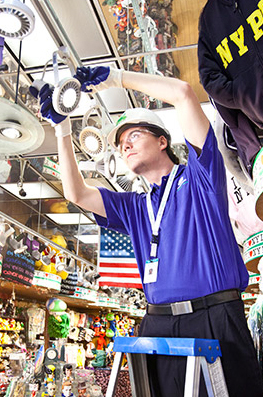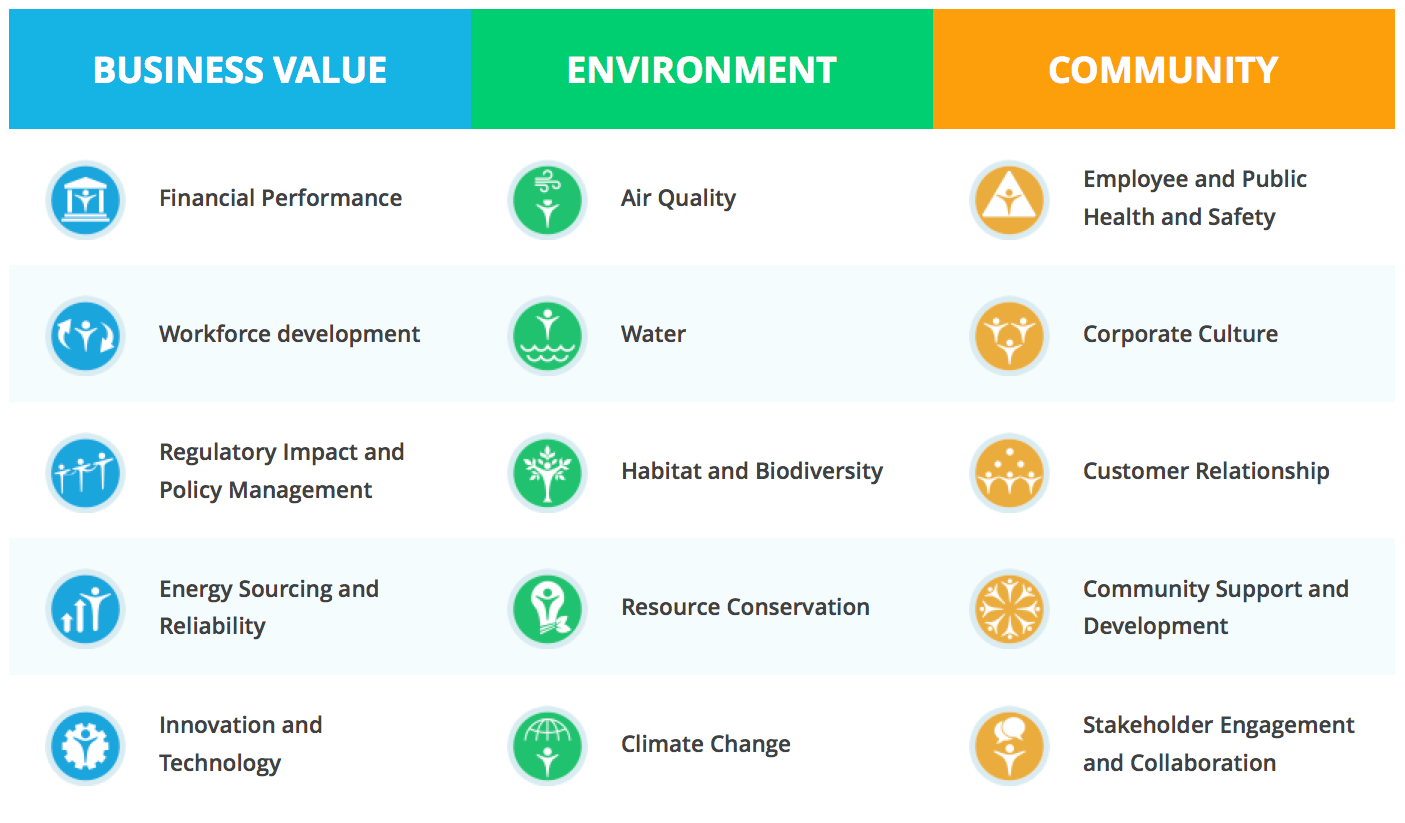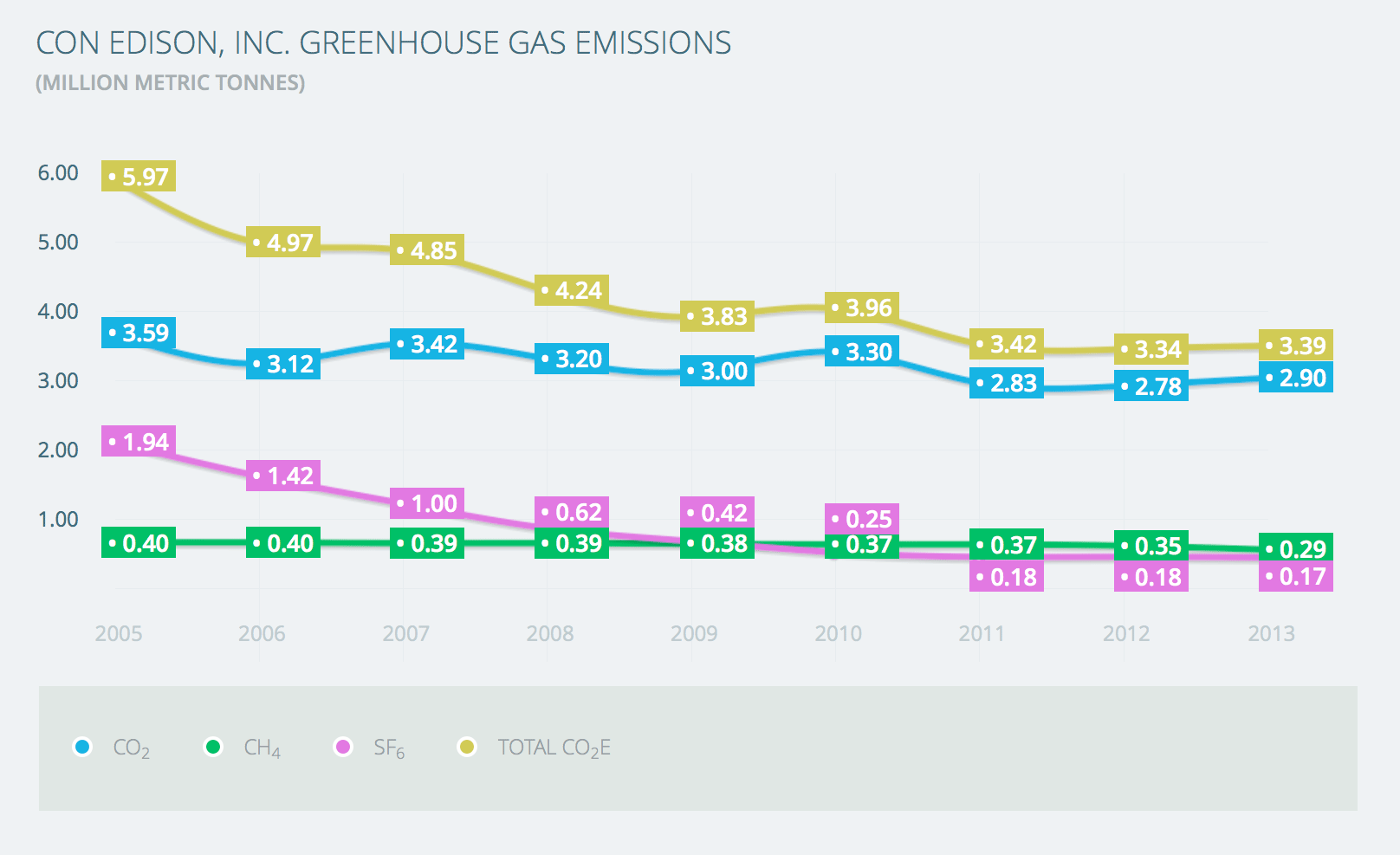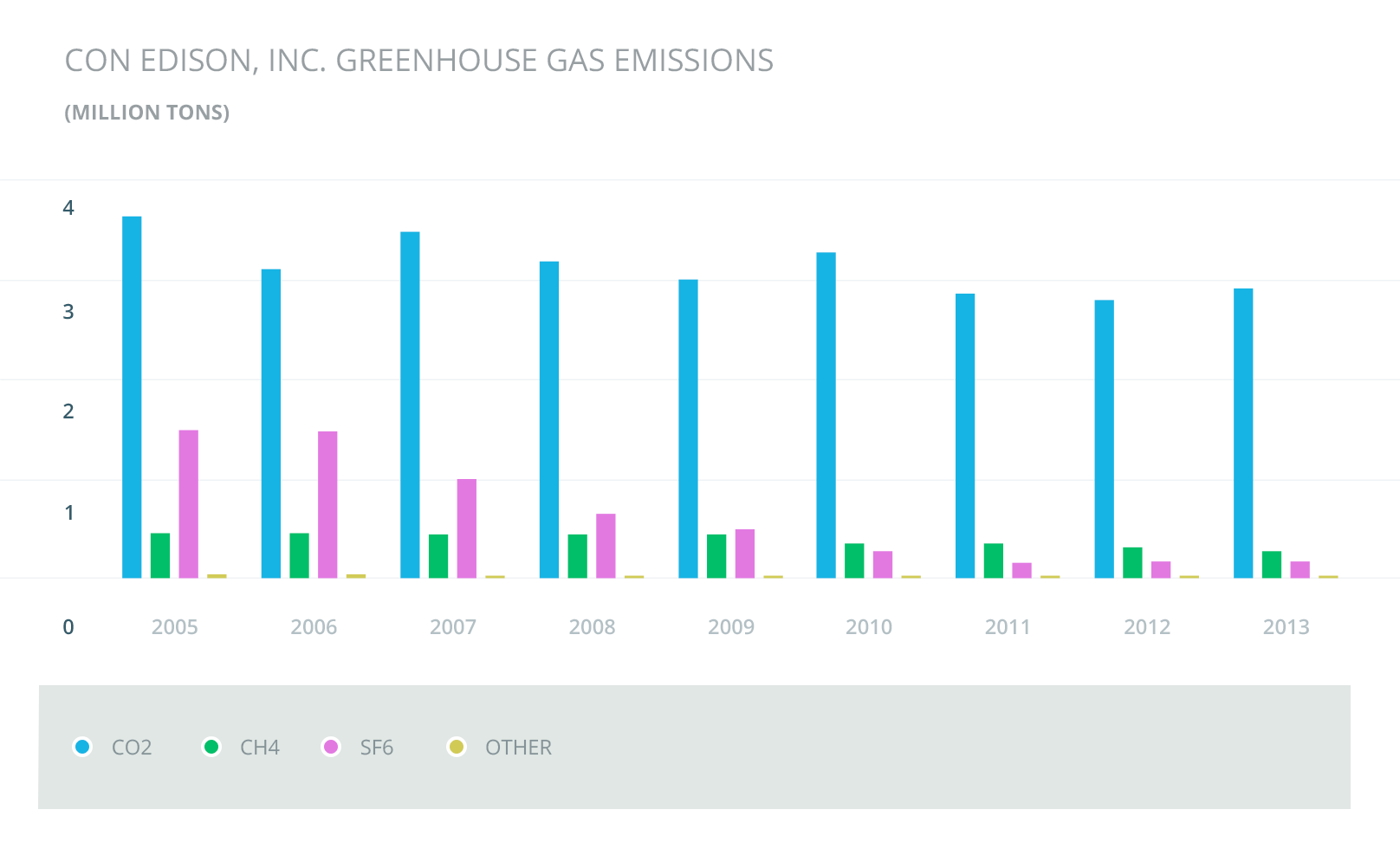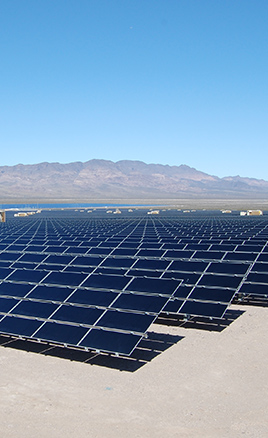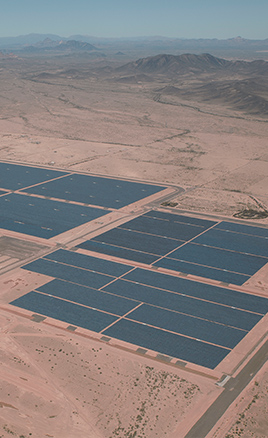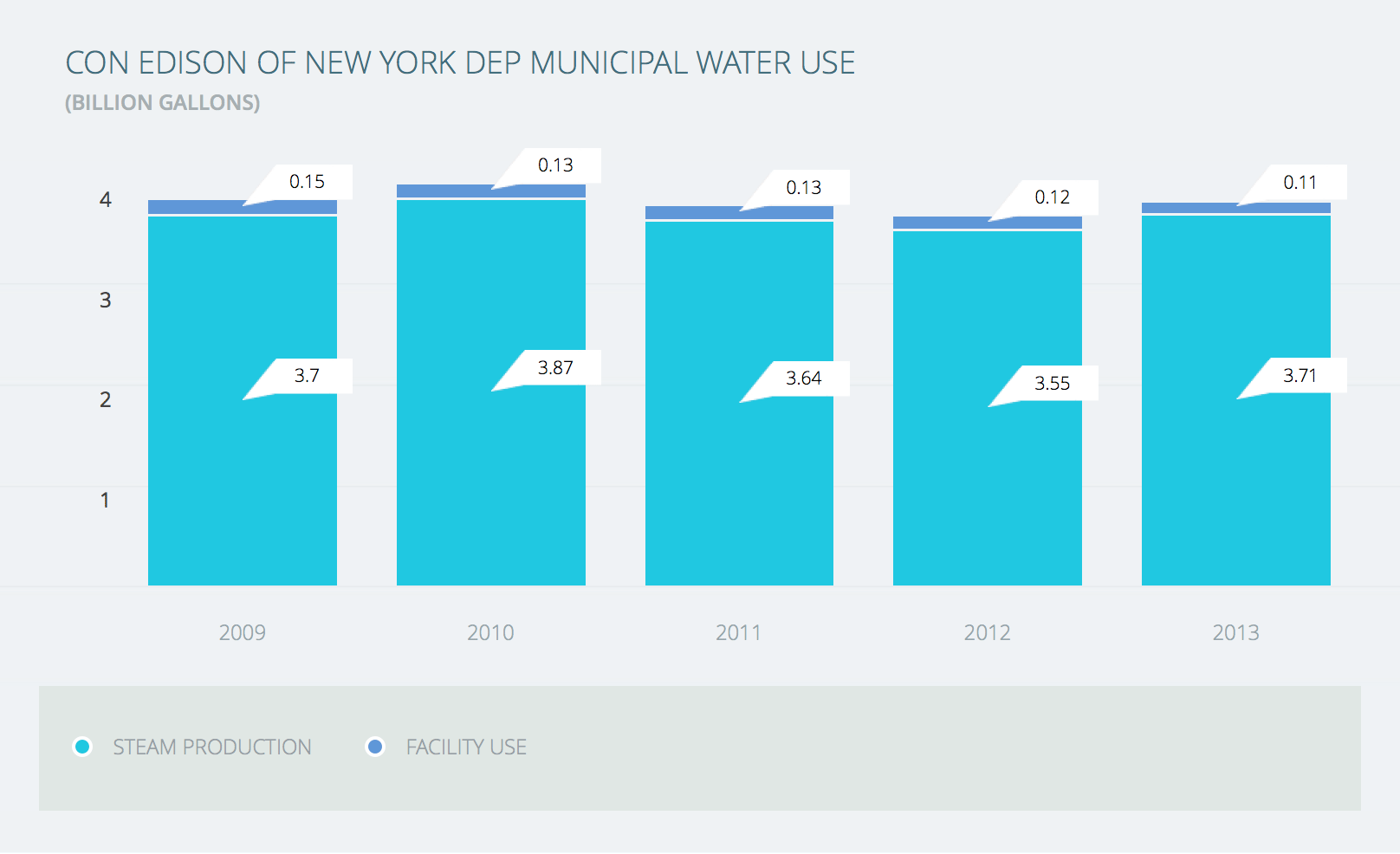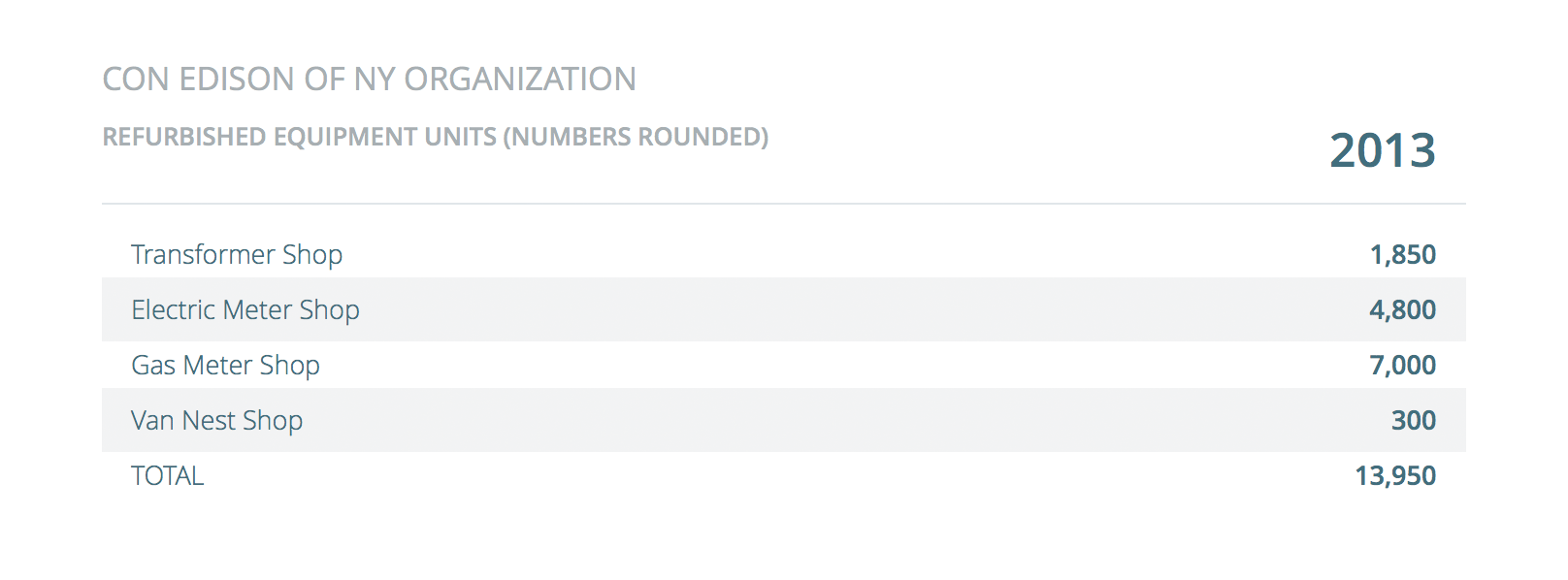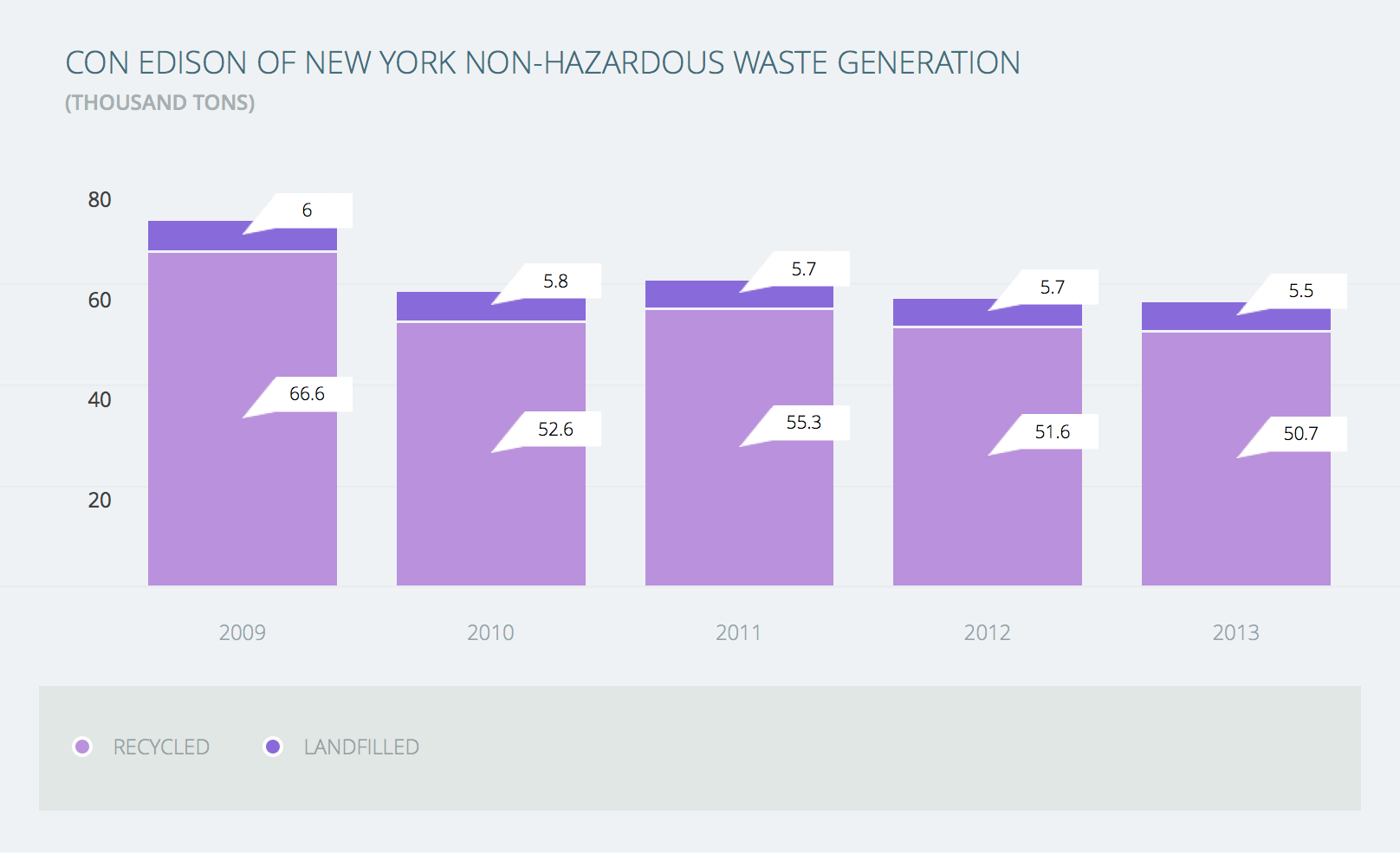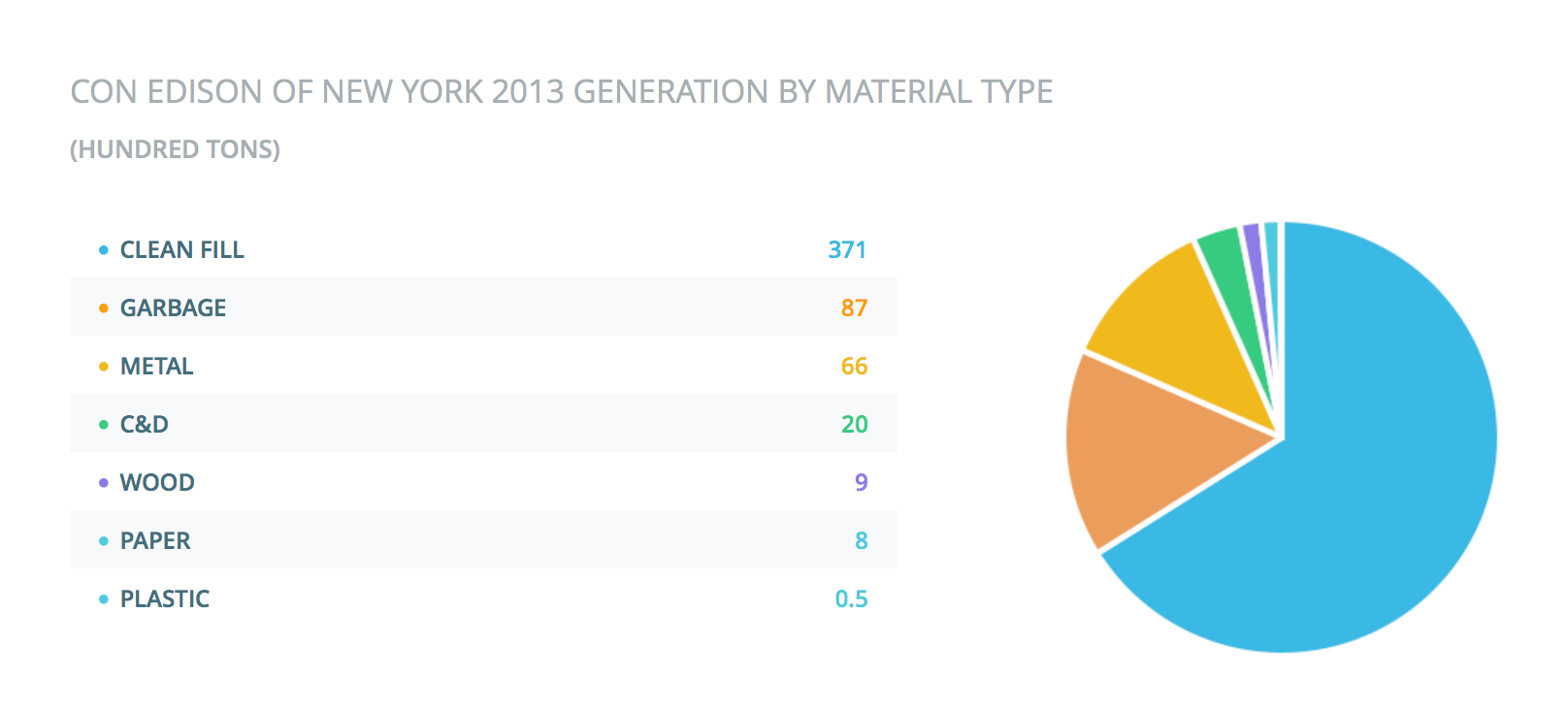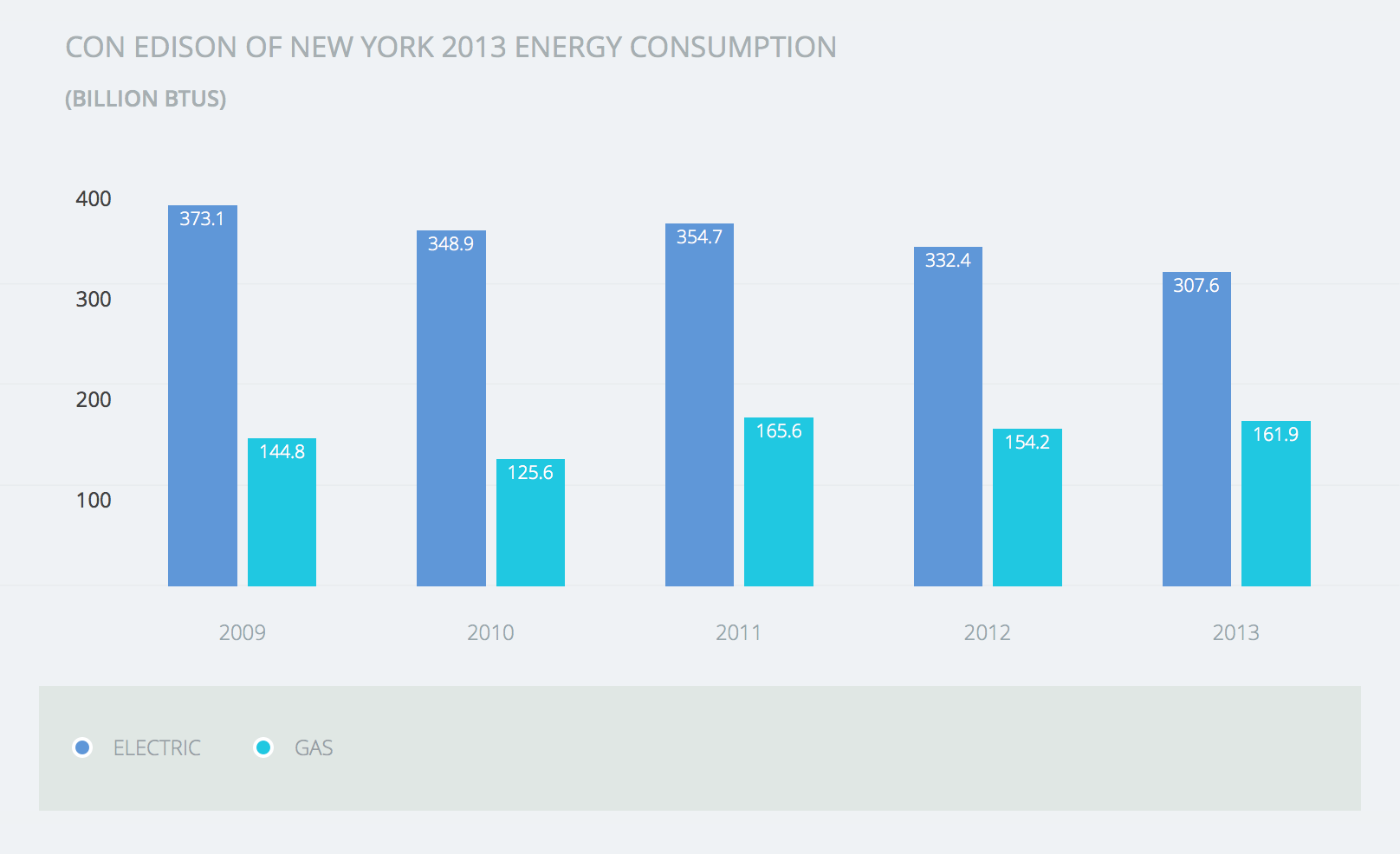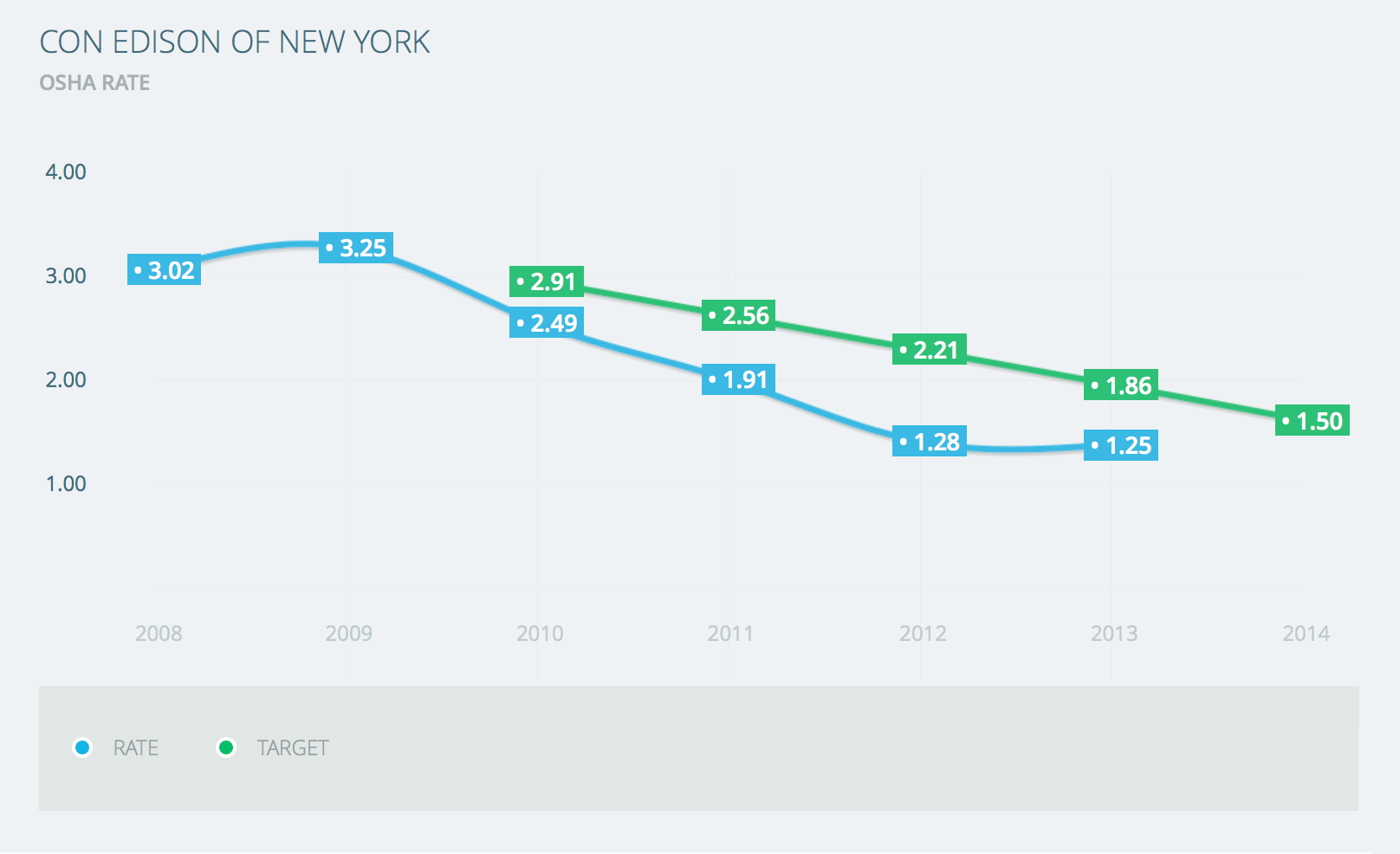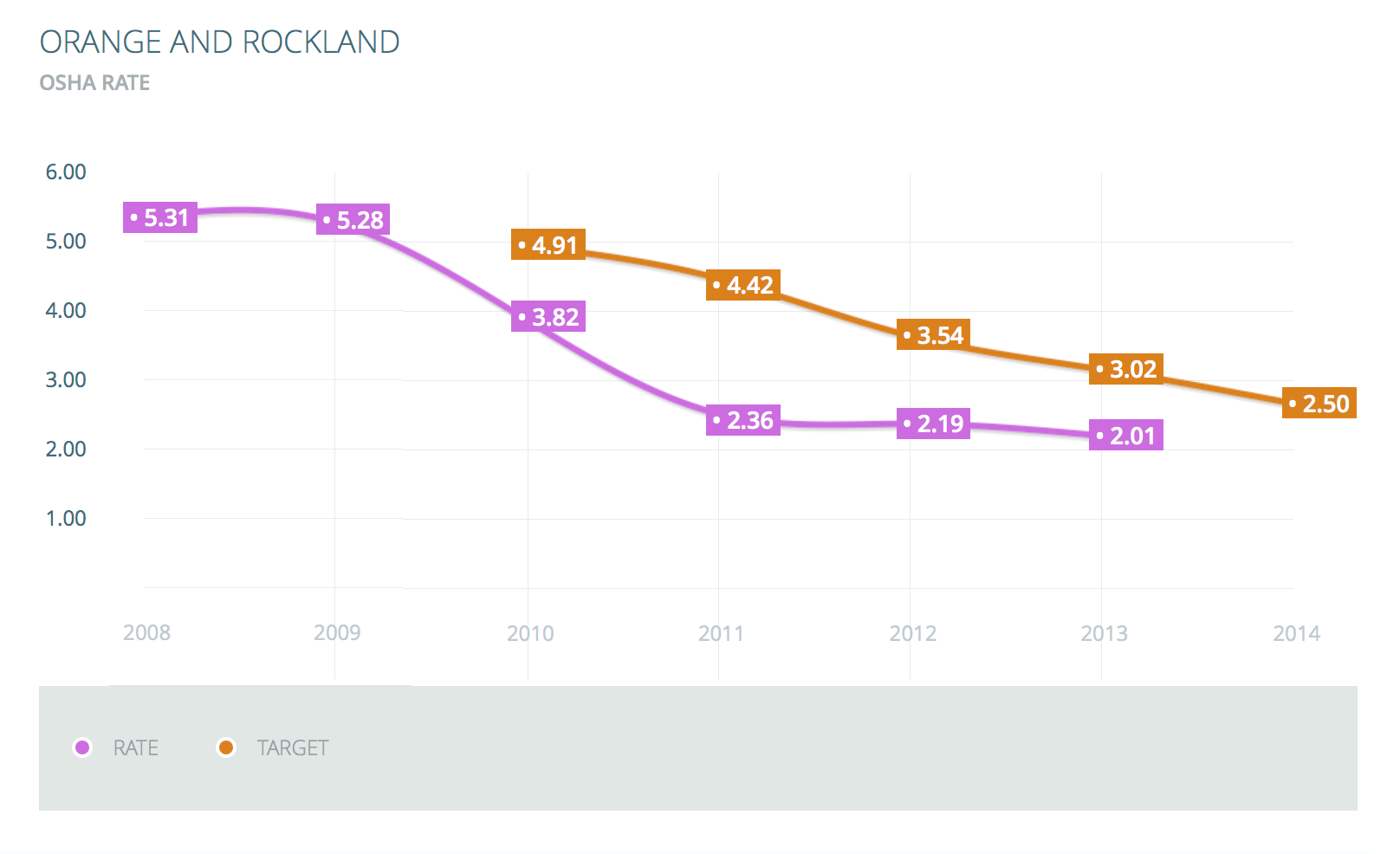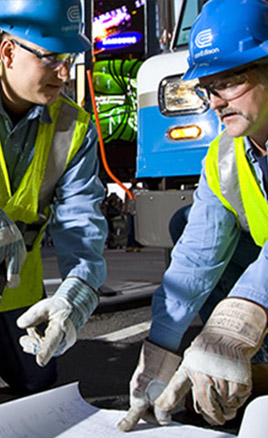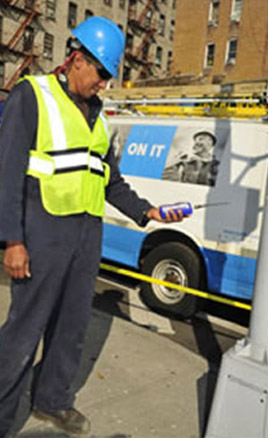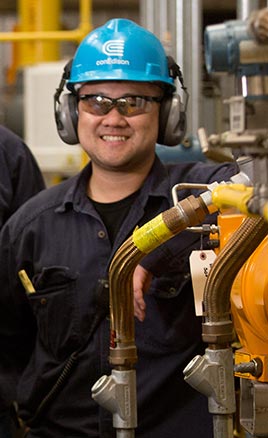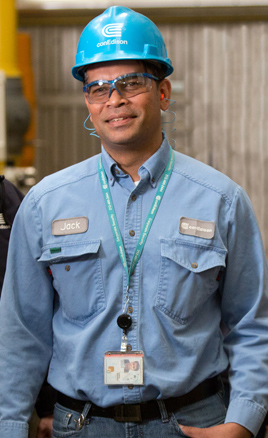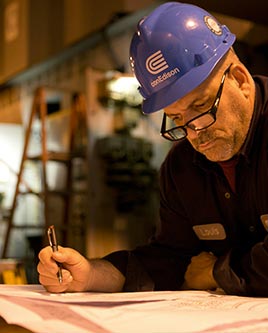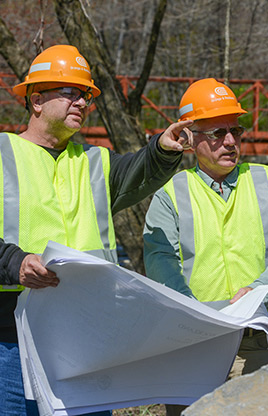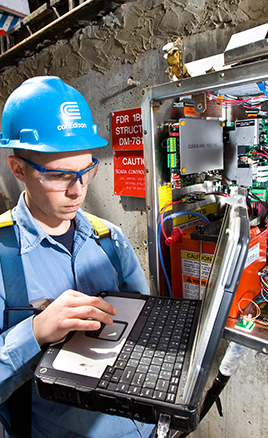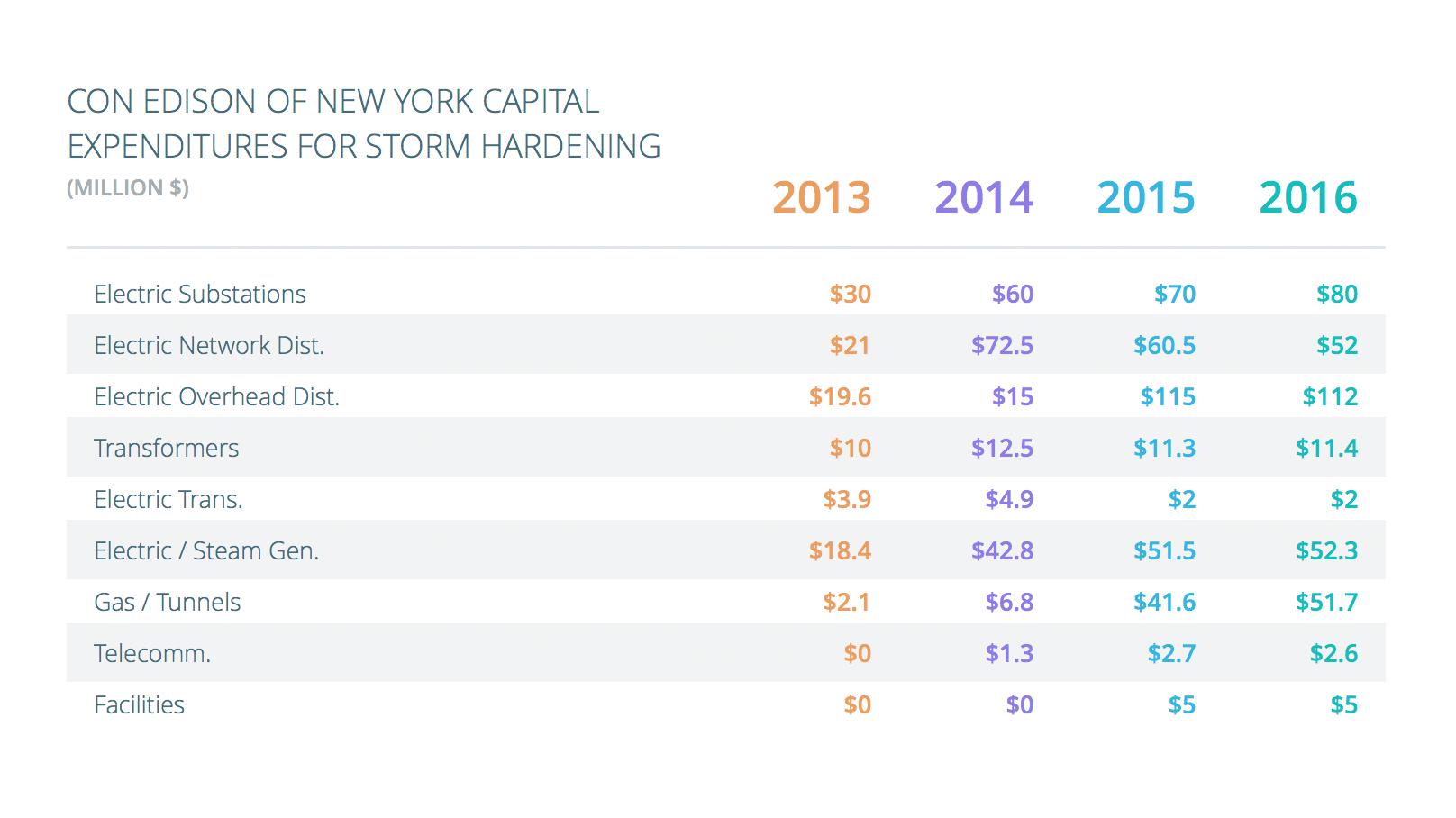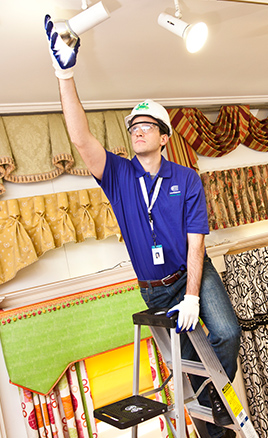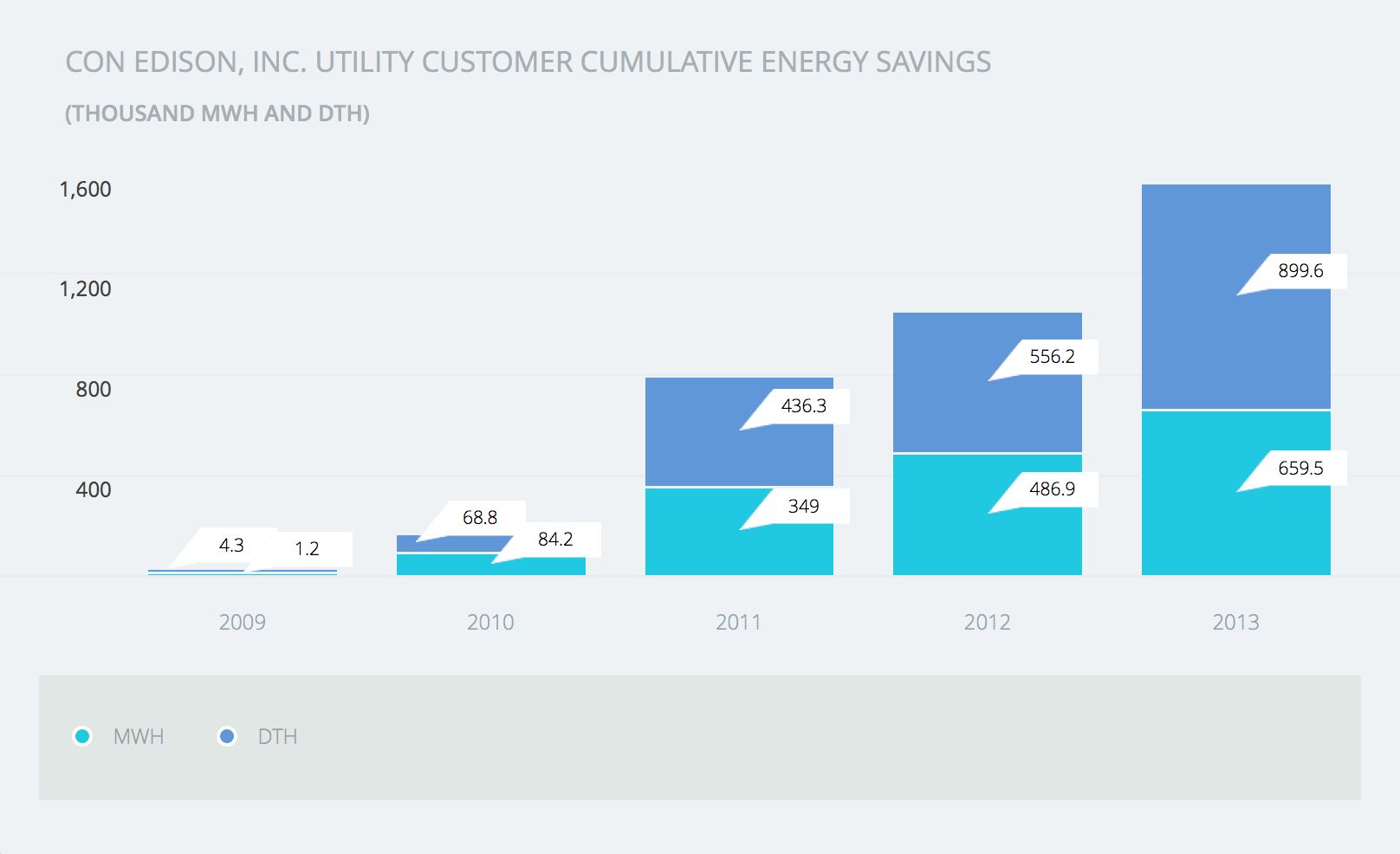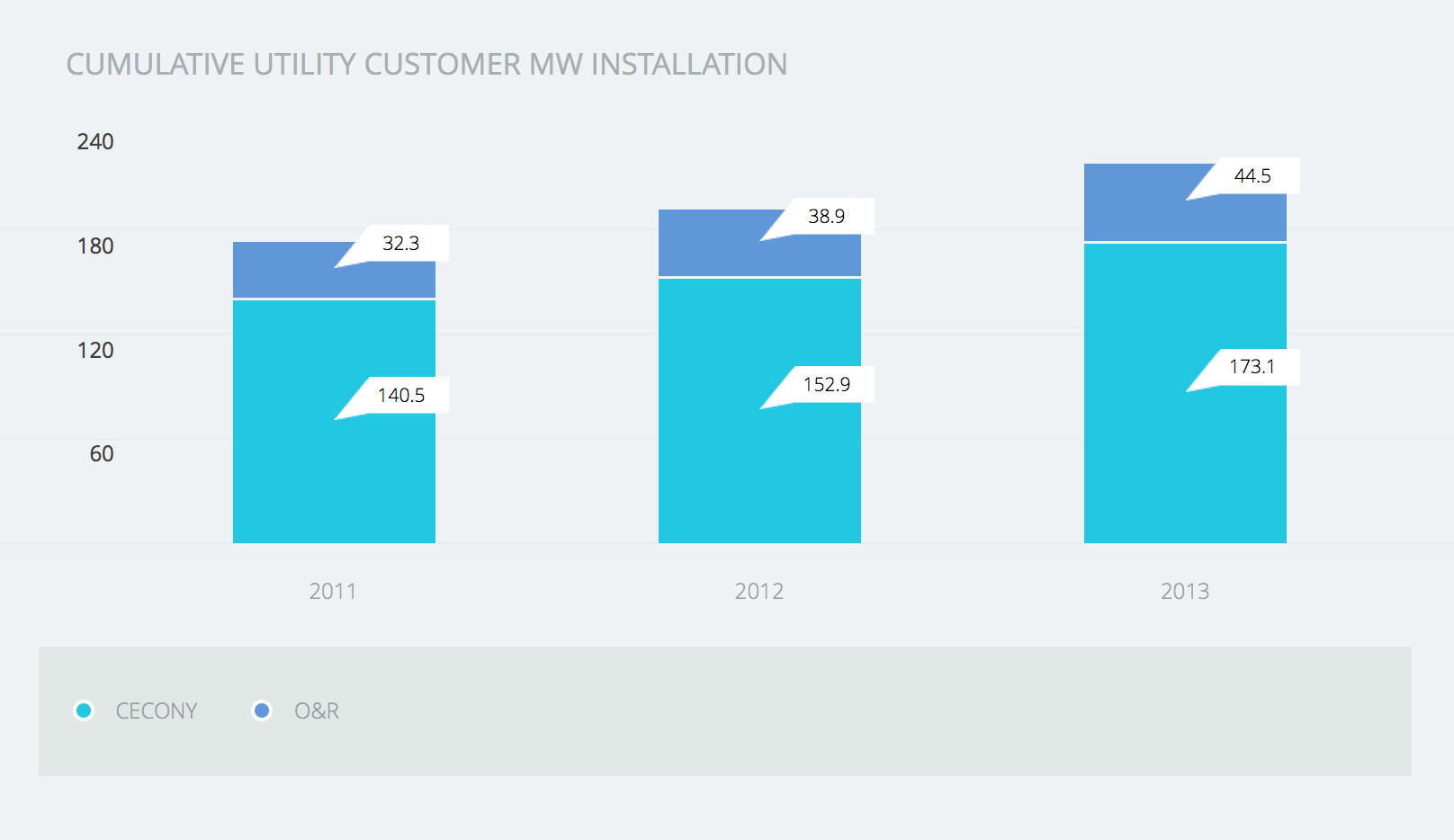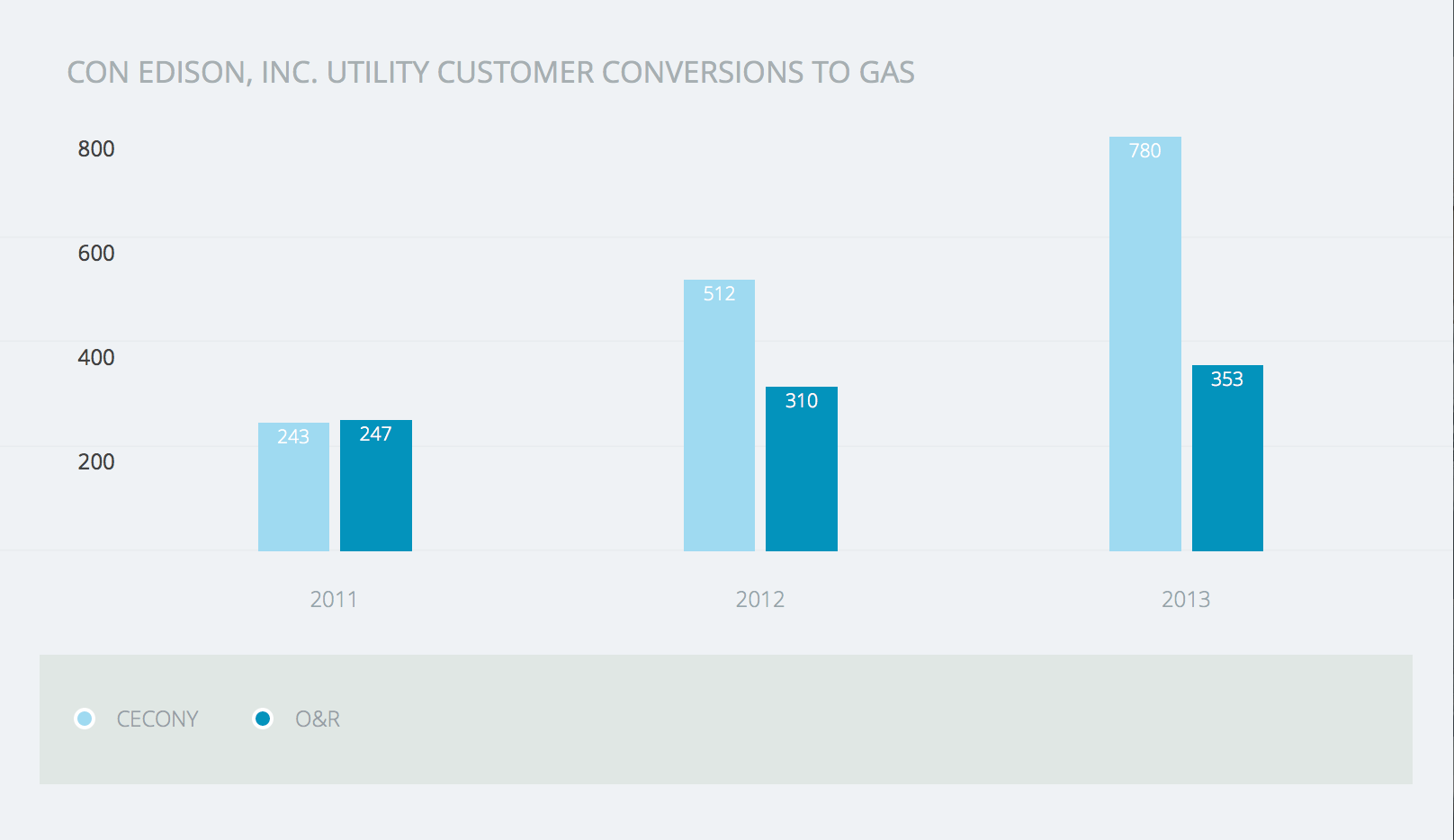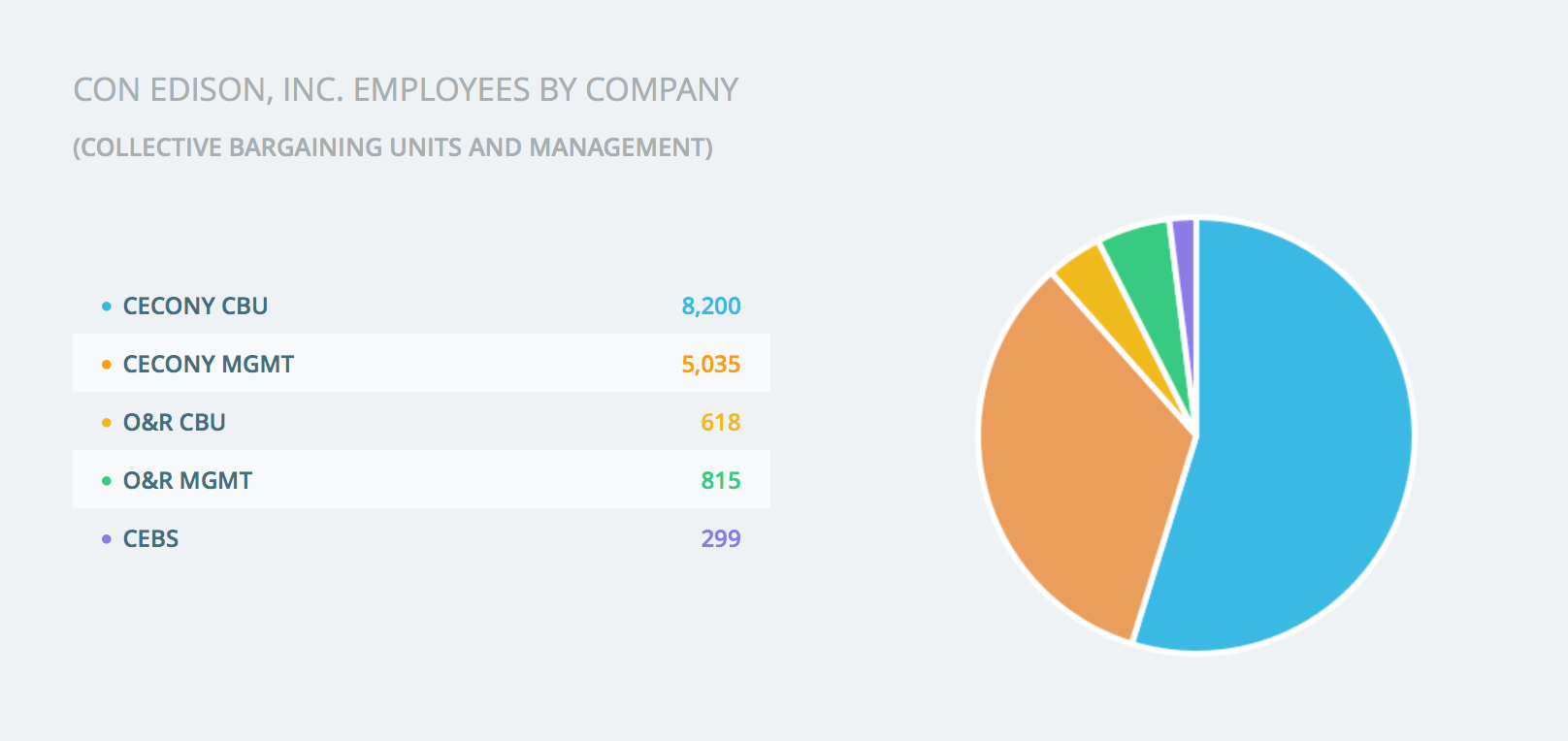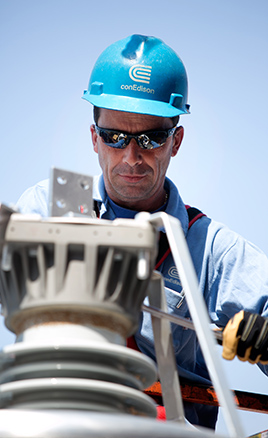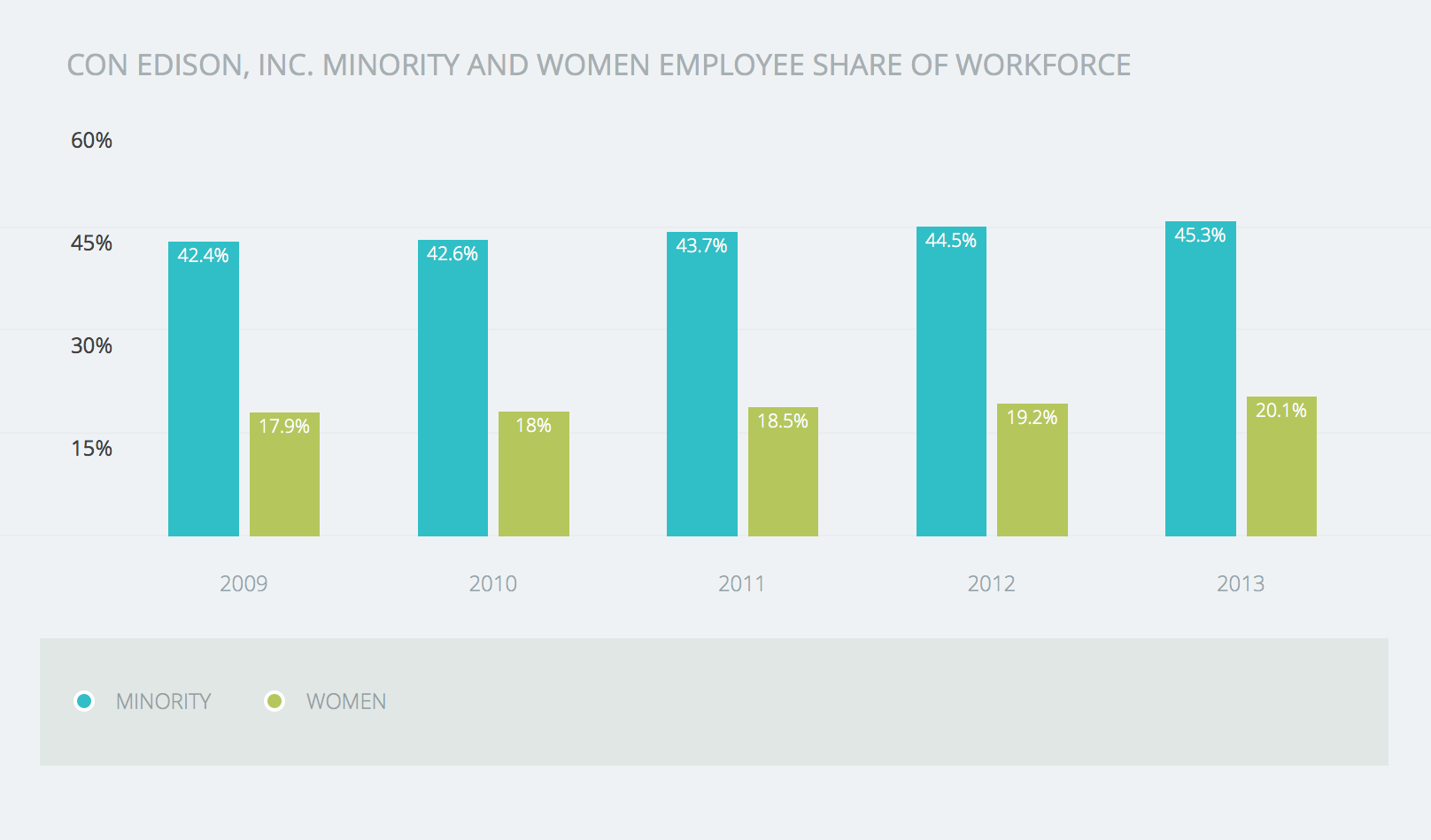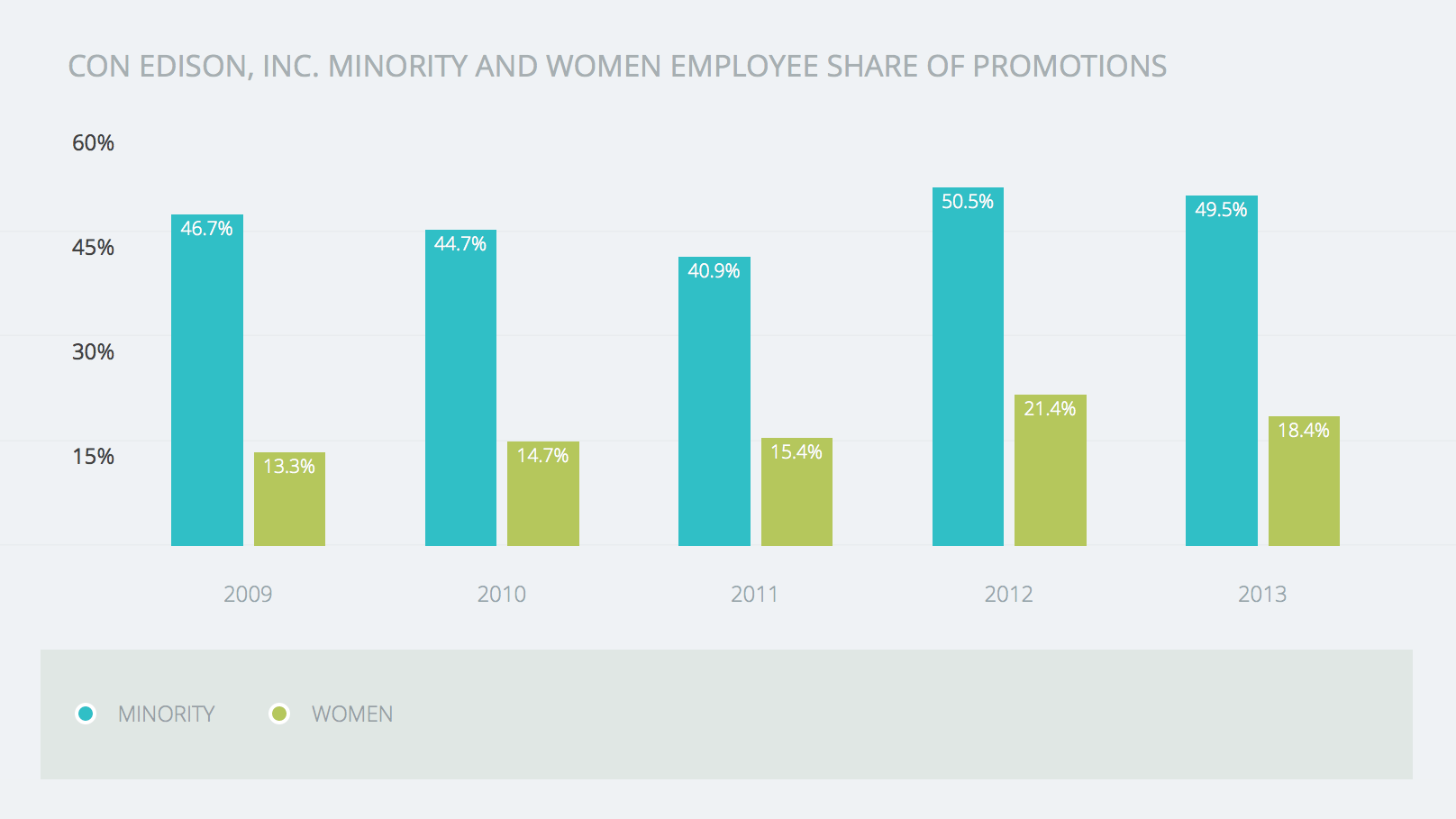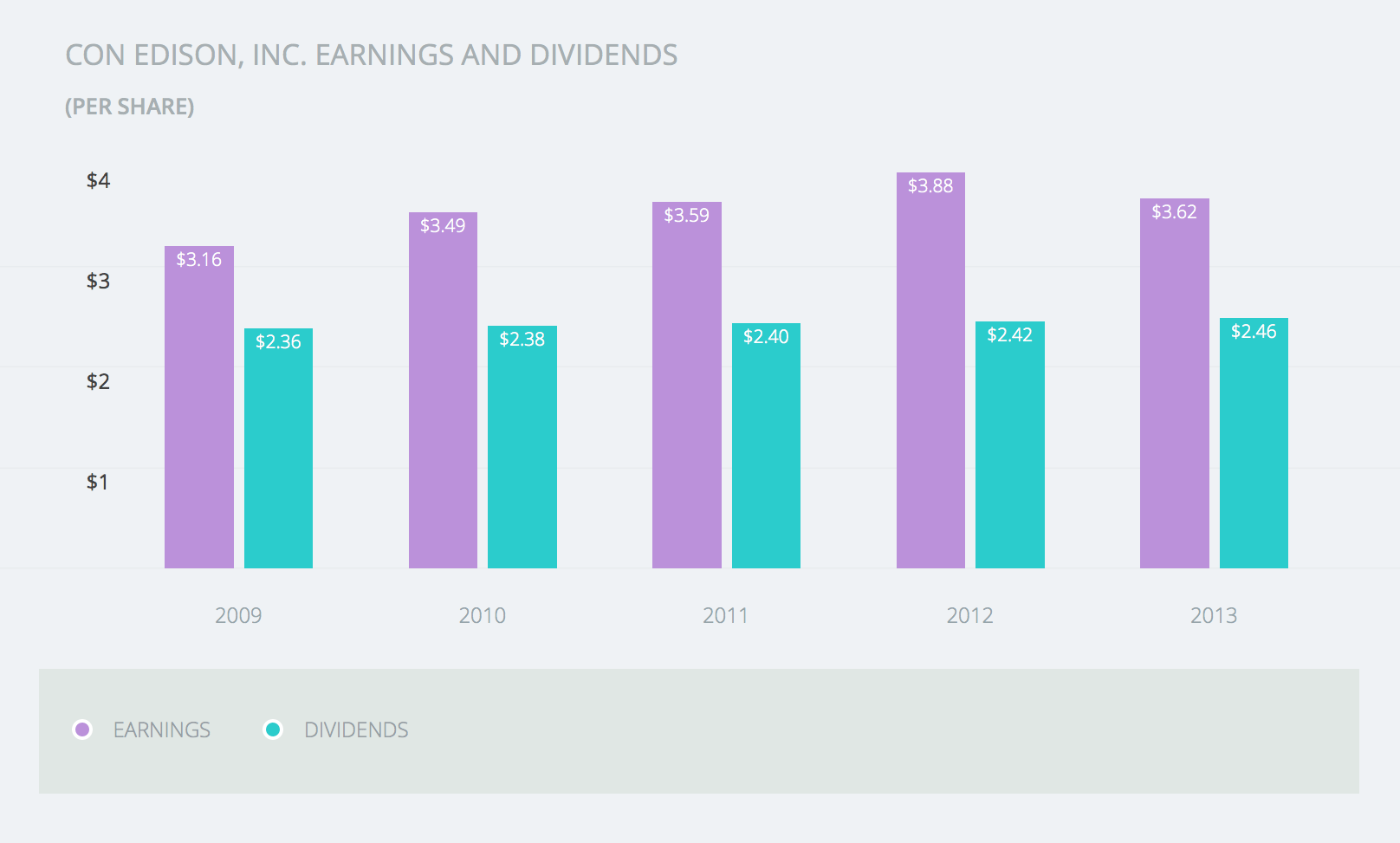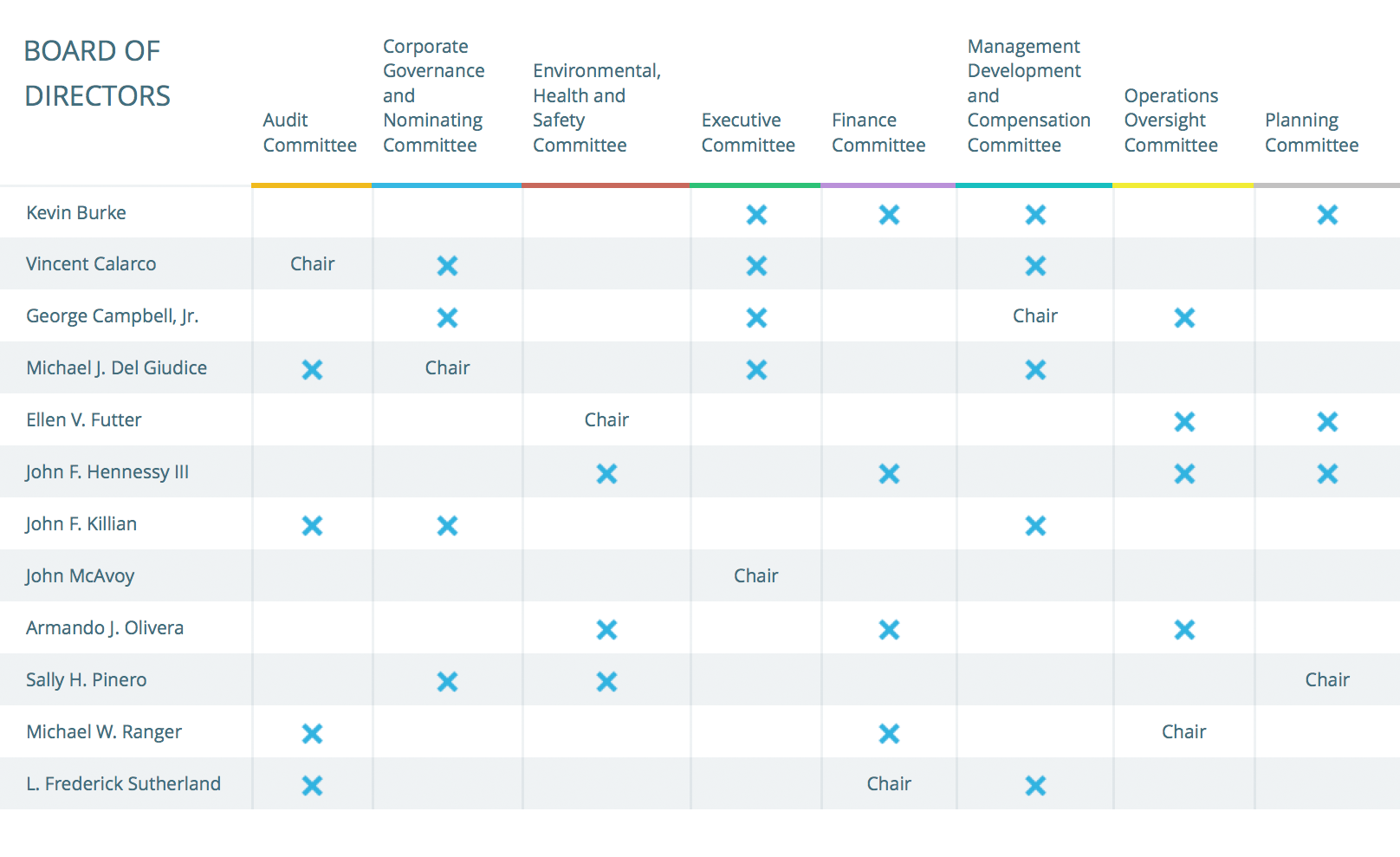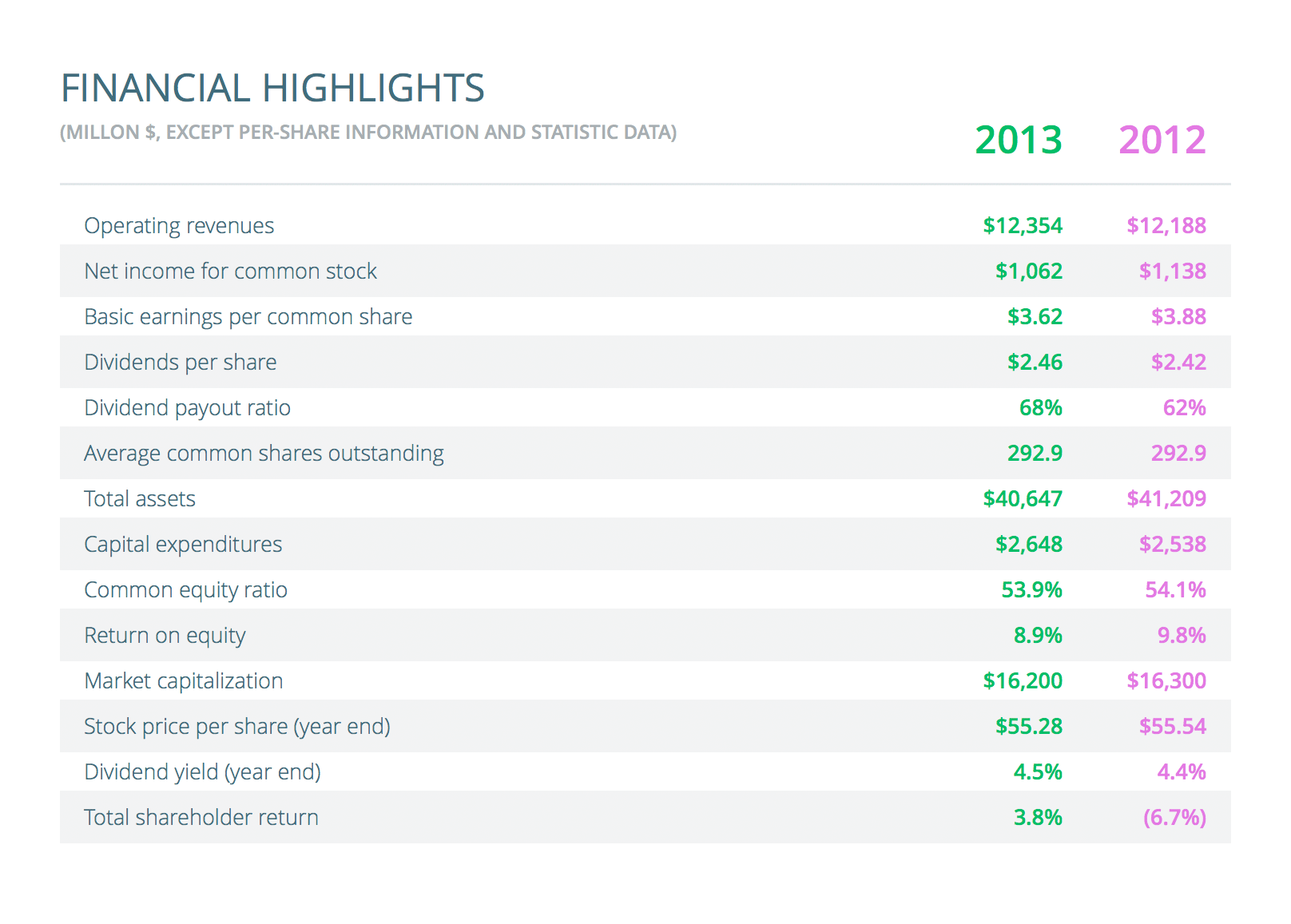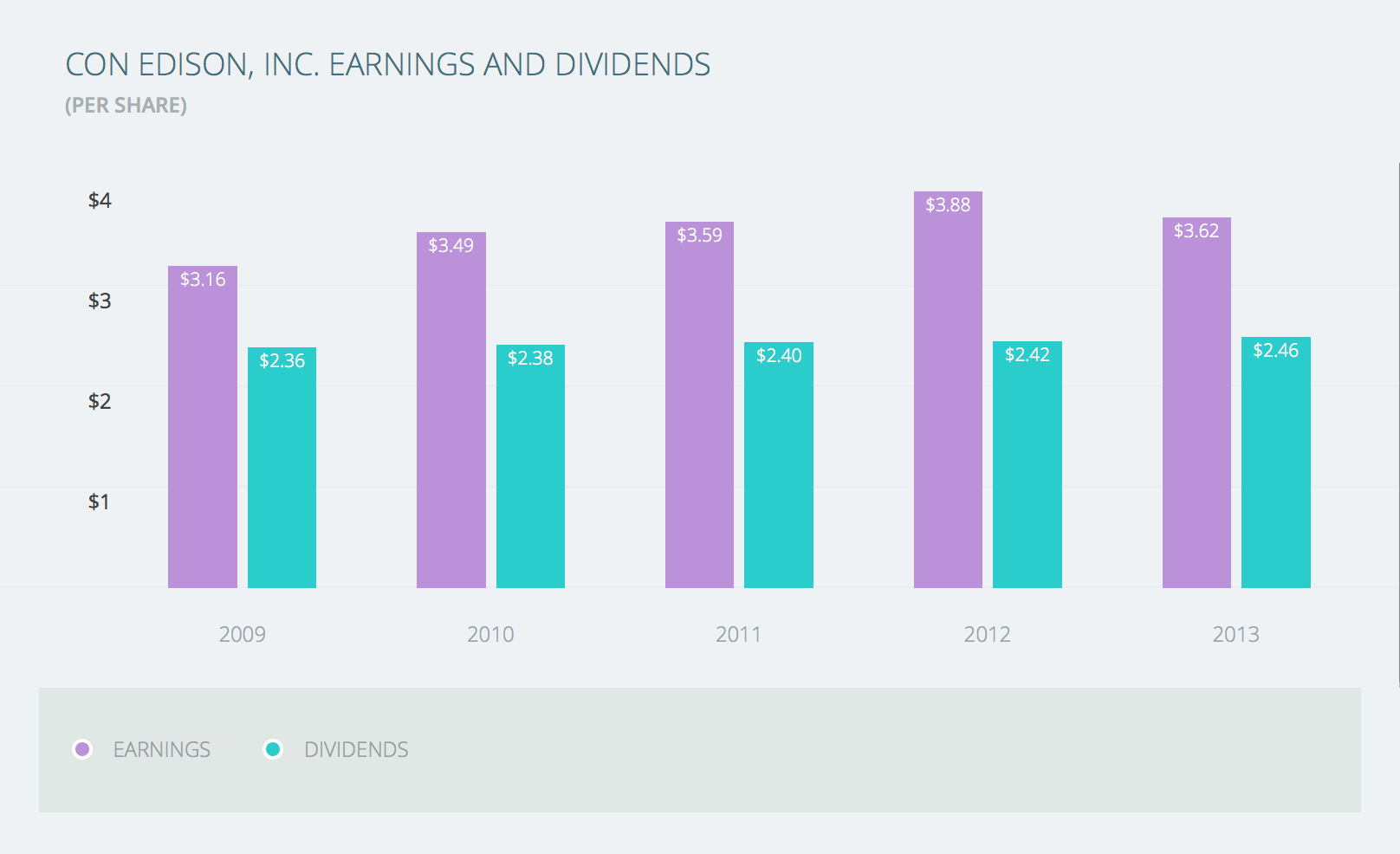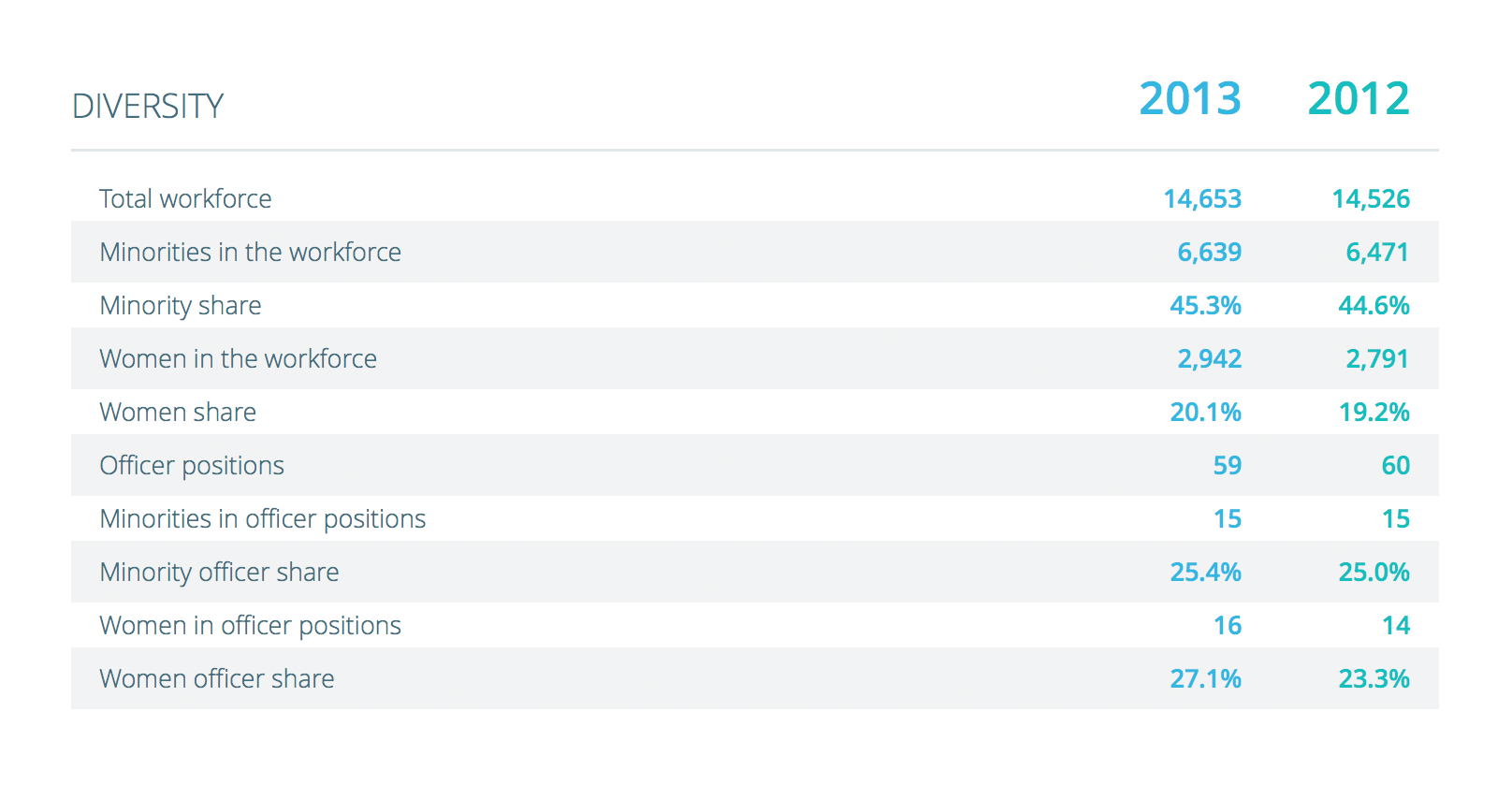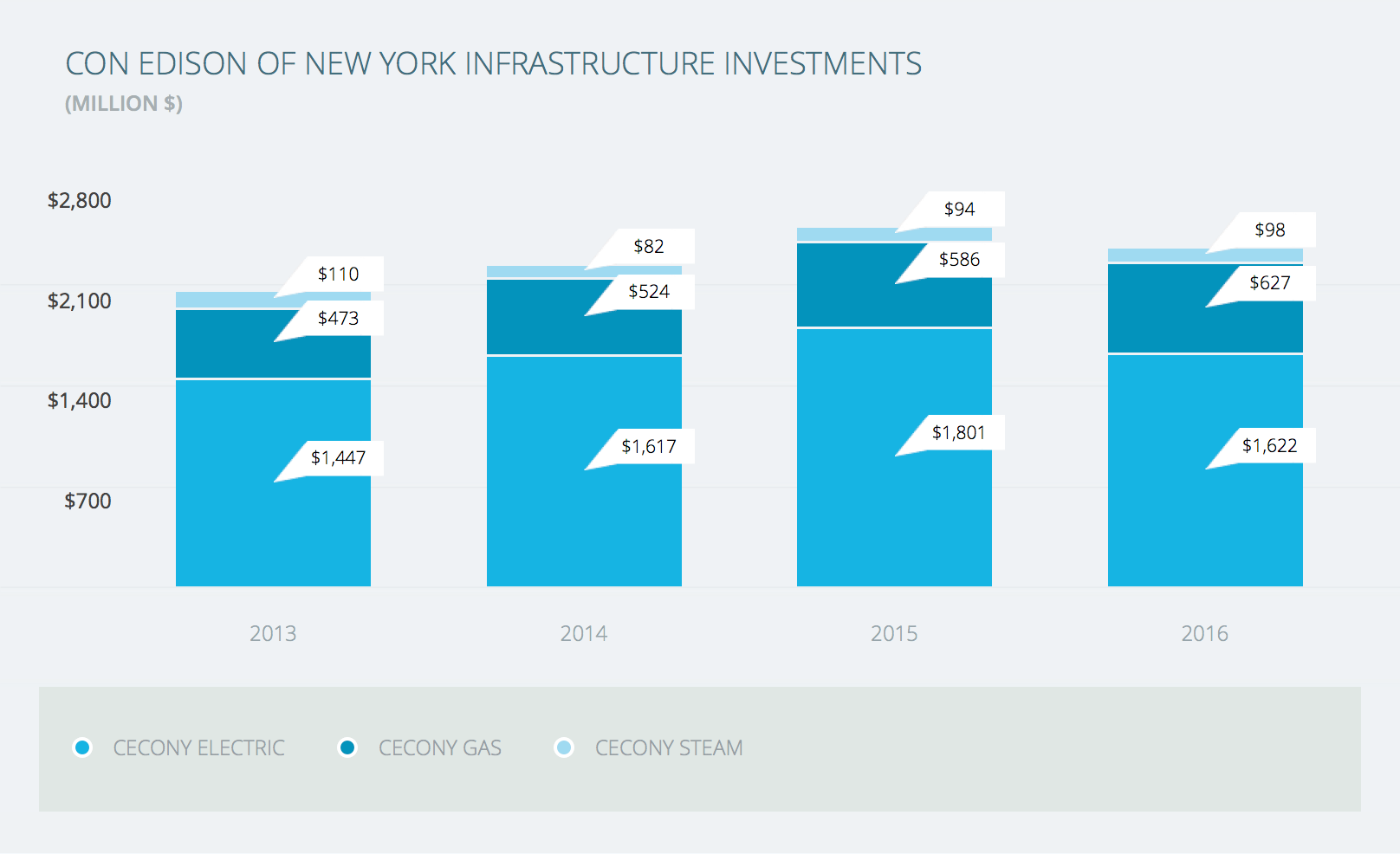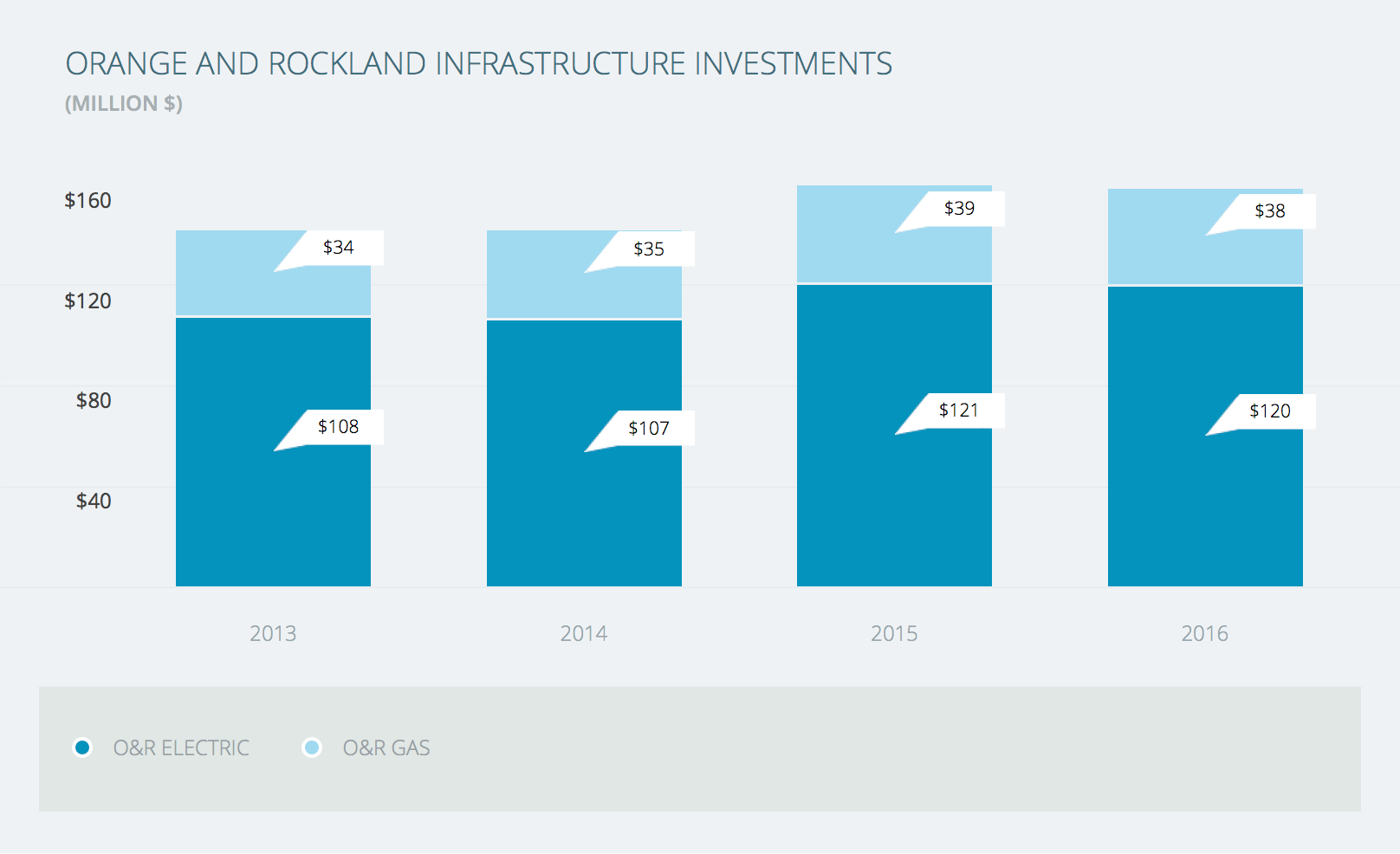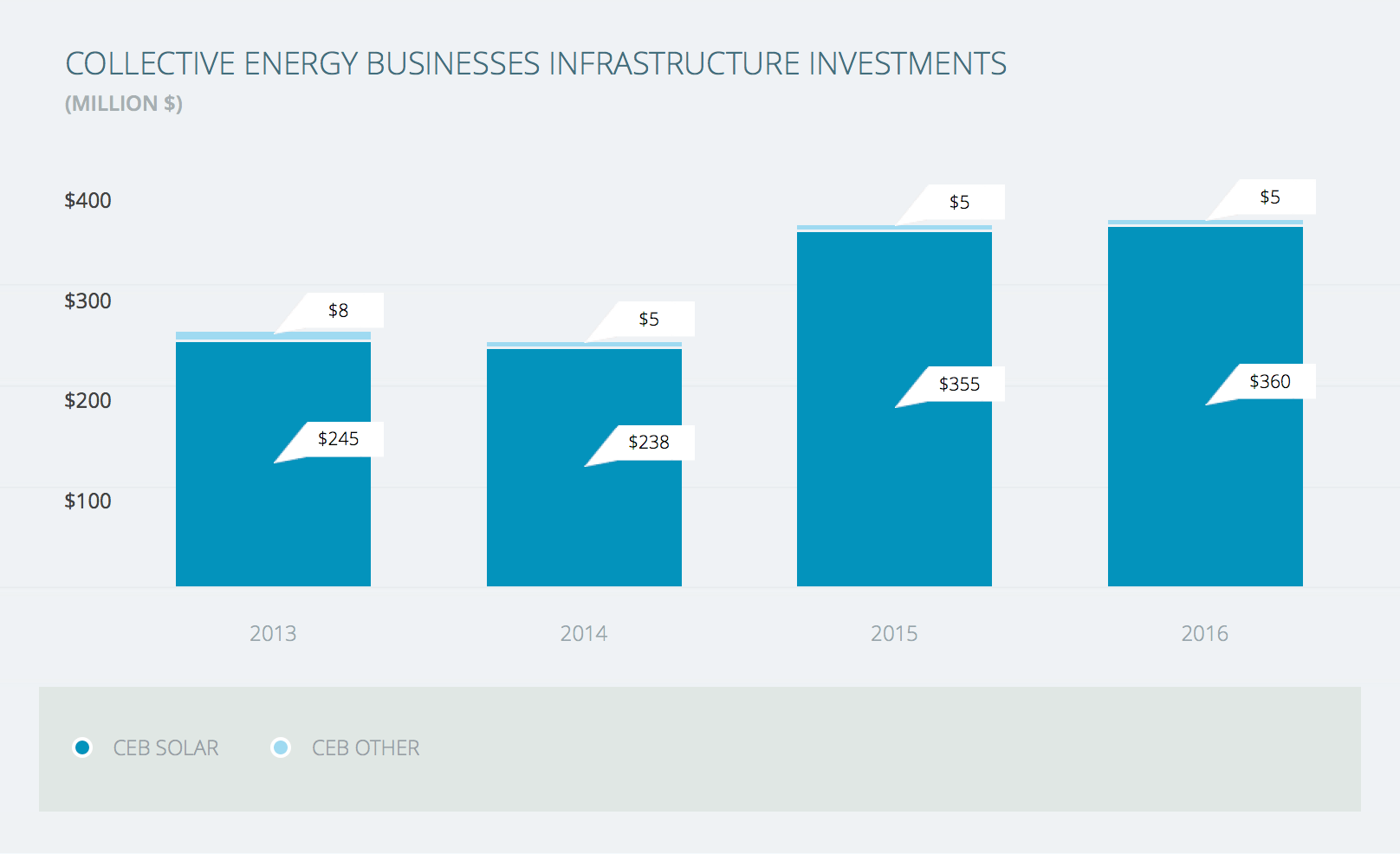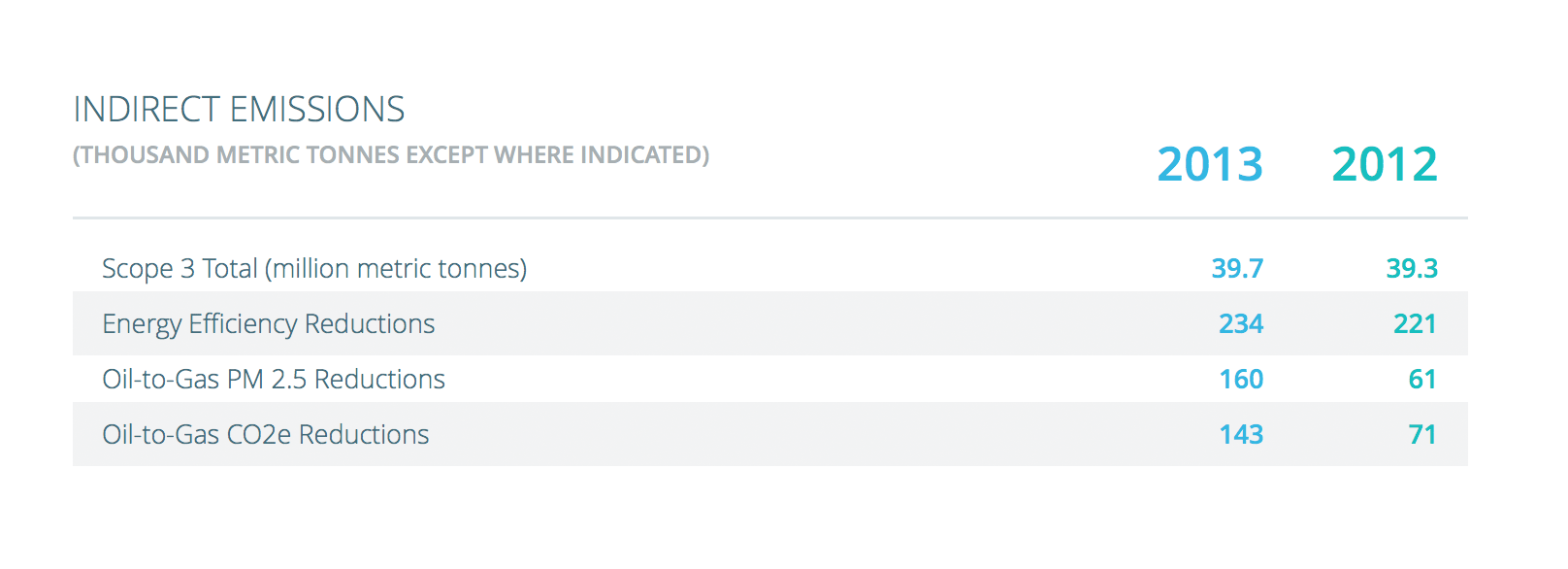Executive Summary
Con Edison, Inc. (CEI) is one of the nation’s largest investor-owned energy companies, with over $12 billion in annual revenues and $40 billion in assets. The principal business segments of Con Edison, Inc. are Consolidated Edison Company of New York, Inc. (CECONY) with regulated electric, gas, and steam utility activities in the five boroughs of New York City and Westchester County; Orange & Rockland Utilities, Inc. (O&R) with regulated electric and gas utility activities in southeastern New York and northeastern Pennsylvania, and electricity in northern New Jersey; and Con Edison’s competitive energy businesses, Con Edison Solutions (CES), Con Edison Development (CED), and Con Edison Energy (CEE).
Leadership and Strategy
From our early history lighting gas lamps to today’s cutting edge electric vehicle and smart-grid technologies, Con Edison has powered New York for 200 years. A population of nearly ten million across our service territory depend on us to provide safe, reliable, and affordable energy to light and warm their homes, run their businesses, and help the region grow. The theme of this year’s sustainability report – 5 Businesses, 1 Goal: Evolving for the Future – is reflective of our changing industry, customer needs, and regulator priorities. We recognize that to be successful for the long-term, to be truly sustainable, our company must evolve to meet those needs and priorities. Our new Utility of the Future team is working to better define a roadmap for that evolutionary process.
This report outlines the many components of our sustainability strategy which, partnered with our Integrated Long Range Plan, will strengthen Con Edison and help us prepare for the challenges ahead, so that we can thrive and grow as a company for the next 200 years and beyond. Our sustainability strategy outlines how we strive to be an enterprise valued by all stakeholders, incorporating a focus on business, environmental, and community value as the foundation of our company strategy and our employees’ day-to-day activities. This vision is supported by six principles and 15 Key Sustainability Aspects which are mapped throughout this report using the icon mapping detailed in the sustainability strategy section.
In 2013, we experienced challenges associated with the Metro North power outage and a hot summer with new record peak energy usage. Significant work was involved with our continuing commitment to fortify the future, as we invest in updates to improve the resiliency of our systems as a result of Superstorm Sandy. We overcame these challenges and are proud of our many achievements throughout the year, especially in the areas of safety performance, strategic partnerships, environmental performance, and the vitality of our business as a whole.
Managing Our Business
As we further evaluate what the utility of the future means, we recognize that there are essential aspects of our business which will always remain fundamental to our success. We are committed to minimizing our impact to, and enhancing, the environment in which we work. There are five primary areas of focus related to our environmental stewardship disclosure: air quality, water, resource conservation, habitat and biodiversity, and climate change.
- In 2013, we continued with our efforts to reduce our direct greenhouse gas emissions, achieving a 43 percent reduction from our 2005 baseline. We also continue to assist our customers to reduce their own carbon footprint through our energy efficiency programs, oil-to-gas conversion program, and support of both distributed and renewable generation.
- As one of the largest consumers of municipal water in New York City, we purchased over 3.8 billion gallons of water, approximately 110 million of which was used for basic water and sewage services at our facilities while the rest was used to generate steam. A number of water conservation projects were started in 2013 which are helping us to reduce our consumption moving forward.
- The wise and effective use of natural resources is one of Con Edison’s five key EH&S objectives. We continue to focus on reducing, reusing, and recycling to minimize consumption. This applies to our use of materials as well as our use of energy and water and we were proud in 2013 to again have a recycling rate of 90% for our non-hazardous waste.
- Our primary impact on habitat and biodiversity is on our overhead transmission rights-of-way (ROW) and in 2013, we continued to enact our Land and Vegetation Management program which was developed, in part, to encourage biological diversity along these passageways. We’ve also undertaken an initiative in partnership with the New York DEC to reduce the spread of invasive species in ROW. Additionally, in 2013 we continued to investigate and remediate where needed as we look to manage our environmental legacy.
- Our seven climate change principles help guide our work and in 2013 we completed approximately $36 million of the $1 billion in storm hardening investments as we adapt our system after two of our most significant storms within two years (Hurricane Irene in 2011 with over 200,000 outages and Superstorm Sandy in 2012 with over 1 million outages) and improve our resiliency.
We also recognize safety as a core value and strive to achieve an injury-free workplace. We coordinate a robust safety program, communicate with our employees every day about the importance of identifying and mitigating hazards, and work to empower employees to take ownership of their own safety and that of their teammates. We rely on our employees to identify ways that we can improve safety. These combined efforts resulted in another record year of safety performance, with Con Edison of New York achieving an OSHA rate of 1.25, and Orange and Rockland reducing their rate to 2.01. Along with a commitment to keeping our employees safe, the safety of our contractors and members of the public are equal priorities for Con Edison.
Con Edison operates in a highly regulated environment and is affected by regulatory and social policy adopted at the federal, state, and municipal level. Between the settlement of the company’s rate filing, activities related to the Moreland Commission on Utility Storm Preparation and Response, continuing implementation of the State’s Energy Highway initiative, contingency preparation for the prospective retirement of the Indian Point Energy Center, revisions to the State’s energy efficiency and renewable energy policies, changes to the Regional Greenhouse Gas Initiative (RGGI) program, and creation of the New York Green Bank, 2013 was a particularly active year.
Finally, the company’s continuing commitment to cost management, ethical operations and our rigorous audit program ensure our business remains compliant with regulations, that procedural requirements are correctly implemented, and that we continue to drive improvement.
Reliability and Resiliency
Protecting our systems from extreme weather has long been part of Con Edison’s investment plan. From work as basic as trimming trees around power lines to investments in sophisticated smart-grid technologies, the measures give our energy-delivery systems greater flexibility and reliability.
Energizing the greatest city in the world without interruption demands an uncompromising focus on system reliability and resiliency. Each day, we monitor and maintain system components, work with customers to facilitate major construction and renovation, research and develop new technologies, and invest in infrastructure to serve growing areas of our service territory.
Electric Reliability
Con Edison is known for being one of the most reliable electric service providers in the U.S. — and has been the recipient of numerous reliability awards over the years, including most recently PA Consulting’s 2013 ReliabilityOne™ award for the Northeast region. In 2013, Con Edison of New York’s electric system, serving approximately 3.4 million customers, performed well, successfully serving a record peak demand of 13,322 MW on Friday, July 19th. Additionally, the reliability of Con Edison of New York’s overhead power distribution system was 85 percent better than the industry average. In 2013, Orange and Rockland set a company record for reliability performance, reflecting fewer non-storm-related service interruptions than ever before.
In addition to strengthening our system to better serve growing communities, we’re making our electricity networks smarter through leading-edge smart grid distribution automation technologies. In 2013, we installed more than 4,000 smart devices across our system, including remote sensors, monitoring systems, and switches. Each device is integrated into our enhanced control system, expanding operators’ real-time view of system conditions and increasing their control over the system.
Gas Reliability
Safely and reliably supplying natural gas service to our more than 1.2 million gas customers is a daily focus for both Con Edison of New York and Orange and Rockland. The fuel provides many benefits, including lower emissions and more moderate prices than heating oil alternatives. Con Edison of New York customer use of natural gas reached its highest level in 2013 on December 17, when 1,596,947 Dth were drawn through the system. Con Edison of New York’s total sales and transportation of natural gas reached nearly 280 billion Dth by year end, 2 percent higher than in 2012. At Orange and Rockland, customer demand peaked at 202 million Dth on January 7, 2014. Throughout the year, Orange and Rockland sales and transportation of natural gas reached over 28 billion Dth of natural gas, 17 percent more than in 2012. To meet rising customer demand, we are enhancing our infrastructure to increase capacity and to protect our customers from any impact that might arise from a disruption to the interstate pipeline delivery system.
For all its benefits, natural gas also has risks. The invisible fuel dissolves in air and can only be detected by an odorant that is added to the fuel for safety or by specialized instrumentation. To protect customers, Con Edison of New York and Orange and Rockland work steadily to quickly respond to leak reports, identify, repair, and replace leak-prone pipes, and survey the system for new damage following weather events. Leak response at Con Edison of New York improved in 2013: our personnel were on location within 30 minutes for 89.0 percent of the total potential leaks reported, and within 45 minutes for 99.4 percent of possible leaks reported. In 2013, Con Edison of New York replaced approximately 52 miles of leak-prone pipe against an annual target of 40 miles. Orange and Rockland replaced 93,000 feet of gas main, exceeding the goal to replace no less than 90,000 feet, and reduced active gas leaks to an all-time low.
Steam Reliability
Con Edison provides steam service to 1,703 customers in Manhattan through an underground network of steam pipes, a steam-electric generating station, and five steam-only generating stations. Our steam system performed well in 2013, meeting a peak demand of 8.9 million pounds per hour on January 23. The system experienced no major service disruptions, maintaining its reliability rate of 99.9 percent. Our focus on public safety continued in 2013, as we developed and integrated remote monitoring of structures prone to impact following major weather events. Finally, the completion of gas addition projects at two steam generating stations in 2013 will reduce emissions by 148,000 tons annually.
Resiliency
Late in 2012, Superstorm Sandy impacted more than just our physical assets – it impacted the way we think about storm potential. From 2013 to 2016, Con Edison has proposed to invest approximately $1 billion to improve the resiliency of the electric and gas delivery systems and the steam generating stations. Con Edison of New York completed approximately $36 million in storm hardening investments in 2013, including measures such as reinforced concrete flood walls around critical equipment, submersible pumps to control water infiltration, flood doors and gates at station openings, and expansive foam sealant in cable conduits and troughs which were installed at nine substations and three generating stations that were impacted by Sandy.
Additionally, last year Con Edison convened a Storm Hardening Collaborative in parallel with the rate cases to provide parties an opportunity to fully examine our proposals. A primary focus of the collaborative was the design standard for flood protection. Through discussions with the Public Service Commission, New York City officials, the Office of the Attorney General, and various other rate case parties including environmental groups, it was agreed that the company would revise its flood protection standard to the most current FEMA 100-year flood level plus three feet as the new design standard for retrofitting stations and protecting critical equipment.
Finally, in 2013 we continued to implement system reliability enhancements to support peak use and address emerging issues like physical and cyber security.
Meeting Community Needs
Con Edison has a long tradition of contributing to and maintaining the social, cultural, and economic vitality of our service areas. Our community is comprised of all our stakeholders including customers, shareholders, employees, and the over 10 million people that make our service territory the diverse and prosperous region it is known around the world to be.
Customers
At Con Edison we look to offer customers opportunities to cost-effectively manage their energy needs and provide quality experiences that engender trust. Our suite of energy efficiency programs, integration of distributed generation, the ability to convert from oil to gas, our competitive business solutions, and the support of electric vehicle adoption are helping our customers to reduce their energy use, energy costs, and carbon footprint.
- Through the utilities’ energy-efficiency programs, customers reduced their annual energy use by a cumulative 659,500 MWh and 899,600 Dth from the programs’ inception in 2009 through 2013, resulting in their avoiding the release of approximately 258,000 tons of greenhouse gases into the atmosphere. Demand response (DR) is another tool that can be used to help customers conserve in Con Edison of New York’s service territory. In 2013, more than 28,000 participants were enrolled with 295 MW of load reduction. Additionally, Con Edison Solutions provides customers cost-effective energy solutions for commercial, industrial, residential, and government customers.
- Throughout the service territories of the regulated utilities, we are working to empower customers’ innovative energy choices, with an emphasis on targeted areas. The primary type of distributed generation (DG) in terms of MW installed is combined heat and power (CHP). At Con Edison of New York, 90 MW of large (greater than 1 MW) CHP projects came online between 2006 and 2011. Though large project installation slowed in 2011, there are multiple projects in development and we expect an additional 100 MW of large CHP by 2018. In the Orange and Rockland territories, over 22 MW of CHP has been installed. While CHP installations have been significant, our customers have rapidly been installing solar photovoltaic (PV) panels as well. An additional 1,190 (CECONY – 745, O&R – 445) customers installed solar PV last year alone, growing from 33 MW (CECONY – 20.2 MW, O&R – 12.78 MW) at the start of 2013 to 53 MW (CECONY – 34.8 MW, O&R – 18.21 MW) end of year throughout CECONY and O&R’s territories. Additionally, more than 50 MW (CECONY – 37.3 MW, O&R – 12.7 MW) of solar PV development are in the queue for interconnection. We also continue to lead by example in 2013 with the installation of more than 200 panels atop our corporate headquarters at 4 Irving Place in Manhattan.
- As part of the city’s goals to reduce local pollutant emissions and improve air quality, the city will stop issuing new permits for #6 heavy fuel oil by the end of 2015, and will do the same for #4 fuel oil by the end of 2030. Con Edison anticipates that many of these large buildings will want to convert their primary fuel source to natural gas supplied from the company’s gas distribution system. In 2013 we worked with customers to convert 780 New York City buildings burning #4 or #6 fuel oil and 513 from #2 oil, resulting in a reduction of 176 tons of fine particulate matter (PM2.5). Although Orange and Rockland counties in New York do not have any regulatory requirements associated with conversion, Orange and Rockland is also experiencing growth due to oil-to-gas conversion and in 2013, 353 conversions from oil or propane to natural gas were completed, representing the highest natural gas conversion rate in the last four years.
- Finally, we’re seeing growth of electric vehicle adoption throughout our service territory. In 2013, Con Edison had 2,040 electric vehicles throughout the Con Edison of New York and Orange and Rockland service territories, more than tripling the 2012 population of 666. We anticipate that number to increase exponentially as consumer awareness rises and prices plateau. We anticipate 4,000 electric vehicles on the system by 2015, and we are preparing for as many as 40,000 electric vehicles to plug in by 2020.
In 2013 we also saw significant development in the way we communicate with our customers. Utilizing email, text messaging, and social media, we continue to broaden the methods by which we reach our customers to get them the most current information that they need.
Finally, we recognize the importance of energy value for our customers. Our company focuses on the entire customer bill as well as the value customers get from our services, including the reliability of the system. We continue to make good progress on optimizing capital investment through supporting demand side management and employing new system designs and planning process improvements. Additionally, for those customers having challenges making their payments, a full suite of assistance options are available to help them meet their needs.
Strategic Partnerships
Con Edison supports hundreds of nonprofit organizations in New York City, and in Westchester, Orange and Rockland counties whose programs illustrate our dedication to healthy and sustainable communities. We commit our time and nearly $8 million in charitable funding. For gifts to academic institutions, Con Edison provides a double match for employee and retiree gifts up to $3,000, and a single match for gifts of $3,001 up to a maximum of $7,500 in one calendar year. In addition, Con Edison enhances its support of nonprofit organizations through in-kind, non-cash donations. For example, we donate compact fluorescent light bulbs, services, and loaned labor, whereby an employee with a particular expertise or skill assists a nonprofit on a short-term project or program.
In addition to financial support, our employees are actively engaged in our strategic partnerships program. Con Edison employee and retiree volunteers participate in diverse and innovative activities at nonprofits throughout our service territory, and donated more than 5,900 volunteer hours in 2013. Additionally, employees served on the governing boards of more than 150 nonprofit groups we support last year.
Employees
Con Edison recognizes that one of our most important resources is our people. We work hard to promote inclusion, ensuring that our employees represent the full vitality of the area we serve. Con Edison’s corporate culture is built around a strong commitment to ethical business practices and we made great strides in 2013 in our culture change efforts. We continue to strive to be open, fair, trusted, and trusting, in all our relationships, both externally and internally. The company’s efforts focus on identifying observable behaviors, recognizing how perceptions become realities and how culture change can only happen as assumptions, mindsets, and ultimately, behaviors change. While we continue to work on these areas from the top down, 2013 saw the development of grassroots efforts at the organizational level as well.
We also know the value of ensuring our workforce has the ability to improve continually through career development. Con Edison’s Learning Center offers more than 800 classes, covering technical courses, as well as skills enhancement and leadership development for Con Edison of New York and Orange and Rockland employees. In 2013, employees spent 565,000 hours doing instructor-led skills-based and leadership training at the Learning Center. Additionally, employees spent 145,000 hours doing eLearning on such topics as Enhancing Customer Relations, Standards of Business Conduct and Safety and Environment training. Employees also have the ability to take advantage of the company’s tuition reimbursement and corporate mentorship programs to further their development.
In line with a commitment to employee development, we look to make every voice heard, fostering an inclusive workplace for our employees to realize their full potential. Diversity at all levels of the company helps us see and understand the needs of our customers, the communities we serve, and the employees we work hard to recruit, develop, and retain. In 2013, Con Edison employed 14,653 people, of whom 45 percent are minorities and 20 percent are women. Con Edison hired 911 employees in 2013. Of these, 54 percent were minorities and 36 percent were women. Minorities earned 50 percent of promotions, and women earned 18 percent of promotions. The percentage of minorities in upper-management positions increased from 25 in 2012 to 26 in 2013. The percentage of women in director-level and above positions rose from 28 to 29 percent. We also partner with Nontraditional Employment for Women (NEW), a nonprofit that prepares women for work in traditionally male jobs.
Finally, we look to attract and retain our talented workforce through a competitive employee compensation program consisting of fair wages, augmented by a comprehensive benefits program.
Shareholders
Our shareholders are critical to our success as we look to be recognized as a financially sound company and a preferred utility. We strive to adapt our business model to industry changes and manage risk to meet our shareholders’ expectation of financial stability and a growing dividend. In 2013, we were proud that Con Edison was named one of the top 40 energy company by Public Utilities Fortnightly magazine, a national industry publication. Additionally, through strong cost management, we were able to again increase the annual dividend for the 39th consecutive year to $2.46 per share.
Supply Chain
At Con Edison, we recognize that our suppliers are an important part of our value chain and their performance can impact our sustainability. The regulated utilities have a strict vendor qualification process, ensuring that the companies we contract with are able to provide the highest quality goods and services at the most reasonable cost for our customers. Con Edison’s award-winning supplier diversity program invites entrepreneurs and executives to partner with us in mutually beneficial business relationships. Our program combines collaboration through programming – such as our partnership with Green City Force – as well as a commitment to purchase goods and services from minority- and women-owned business enterprises which totaled more than $270 million in 2013. Including fuel and gas, expenditures with minority- and women- owned businesses totaled more than $288 million. Along with a commitment to invest in our supplier diversity program, we have committed to spend $3 million annually on green products, which we exceeded in 2013.
A Look Ahead
As we look toward 2014 and beyond, we will use our successes and lessons learned in 2013 to drive continued improvement for all our stakeholders. Our commitment to excellence in all areas of our business, steered by our long range plan and our sustainability strategy, will ensure that our business continues to provide shareholders a fair return while providing our customers reliable service, supporting our local communities, protecting the environment, keeping our employees and the public safe, and identifying ways that we can continue to innovate and modernize our business to better achieve our company’s mission.
If you have questions or comments about this report, please let us know by contacting sustainableconed@coned.com.


